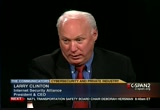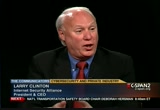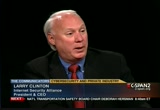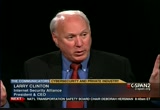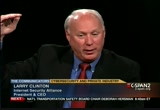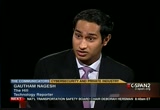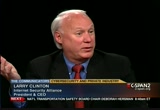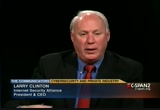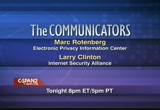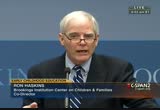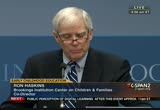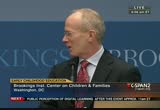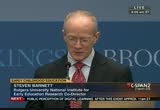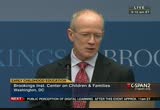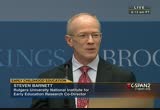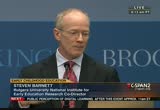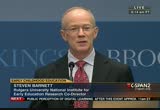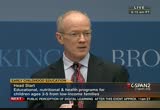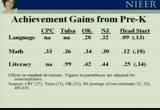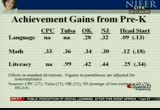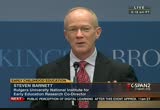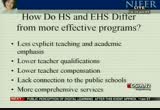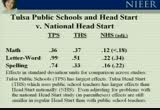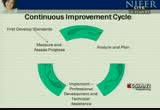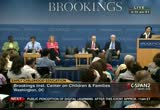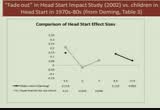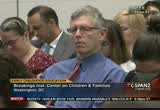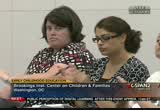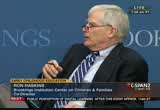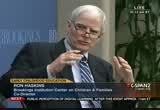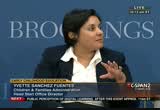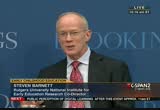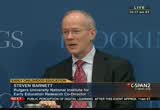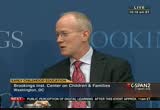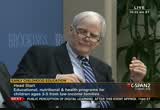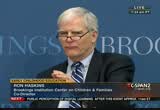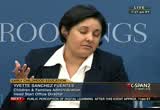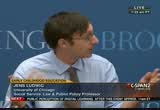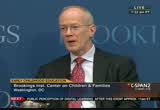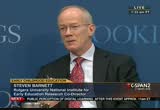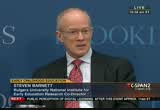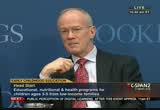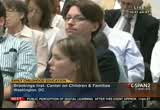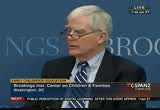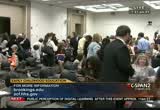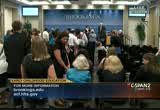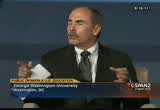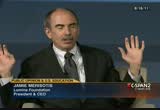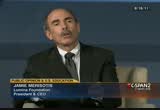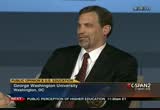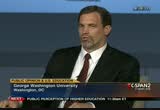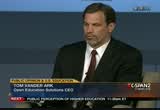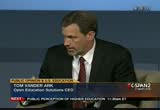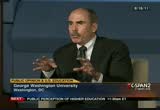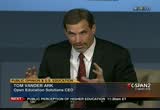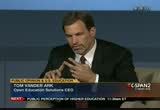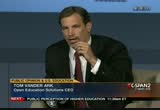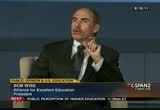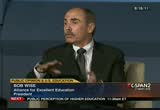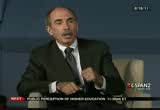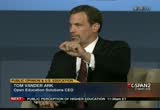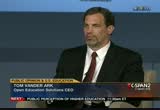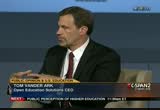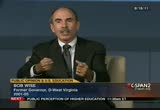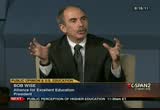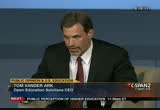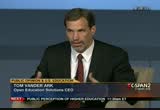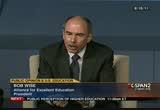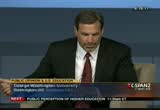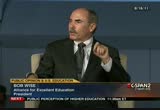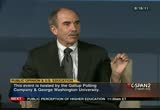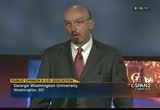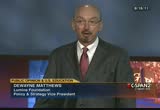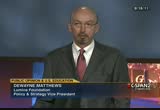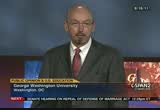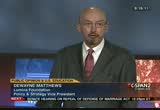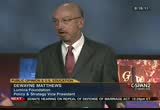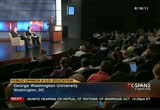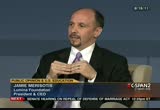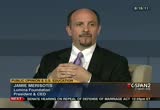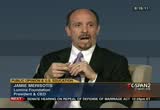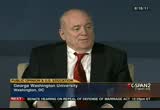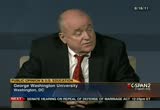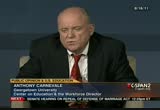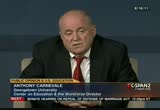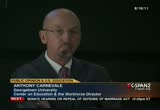tv U.S. Senate CSPAN August 22, 2011 8:30am-12:00pm EDT
8:30 am
>> guest: well, we're talking about two different things here. with respect to sort of consumer breach notification laws, we do support those, certainly. and, in fact, that would be an element of the administration's proposal where we have common cause with them. they've proposed that we have a national breach notification law. so, you know, on the personal side which marc was talking about before, we would probably be in treatment. but i'm not -- be in agreement. but i'm not talking about the loss of social security numbers. i'm talking about the really serious problems that we have; the theft of national secrets, corporate intellectual property, the potential for serious destruction of our nation's critical infrastructure. those are the sorts of attacks that i think we need to go in and root out. but even if we're going to just confront ourselves to the consumer interests, again, what we should be doing is providing the incentives for companies to go find these things, not for them to turn a blind eye to
8:31 am
them. and that's what it's going to turn out to be in a pragmatic world if result of your doing an investigation of your system is your stock price is going to go down. it's going to be really hard for us to get boards of directors to fund those sorts of things, and we want them to. >> host: now, i've spoken to cybersecurity experts who will tell you almost everything of importance has been stolen from american companies online, and if we do want a lot of critical infrastructure firms to take this seriously some form of enforcement mechanism is needed beyond incentives. how would the white house insure adequate urgency from the these firms given that it's widely accepted that security right now is just not acceptable. >> guest: yeah, and, of course, the internet security alliance was created 11 years ago specifically to advocate for enhanced security, so we've been doing this for over a decade. it's just the form of activity
8:32 am
that we are differing on, but we welcome the debate. i don't think that the administration's proposal really does anything that i can see to enhance cybersecurity, but i think that there are a number of things that we could do. so let's, you know, there's a thousand different ways you can divide up cyber attacks, but let's divide it into two different areas which i think is useful. one is there are the kind of basic attacks which can be very devastating, the kind of traditional things we're dollar with. we know tons about how to prevent those basic attacks. in fact, there has been consistent research by the academic community, the private sector and the government all agreeing that if we simply adopted the standards, practices and technologies that we already have, we could stop between 85 and 95% of those attacks, and
8:33 am
the reason we don't do it is the reason corporations aren't doing a lot of things: cost. so we have to find ways to make those investments, um, economically viable for the enterprises who we need to be protecting their systems. so that's one thing we could do, and what we have suggested is that if you use liability, insurance, streamlined regulation, procurements, a range of things that the government can do to provide those incentives. and that would address the vast majority of the attacks. on the other hand, we have these ultra-sophisticated attacks that i was talking about before. now, one of the characteristics of these attacks is the bad guys are going to get in. that's what per sipt refers to. they are so persistent, they are going to get in your system. you really have no perimeter defense. so what that means is that we have to alter the model away from perimeter defense to a
8:34 am
different strategy. however, we have ways to do this, and we have proposed these, proposed them to the government. for example, um, we don't have a lot of control over the attackers when they're out there in the wild as we like to say. the internet is too vast, there are too many entry points, etc., etc. if they want to get in, they're going to get in. but we have a lot more control when they're inside our system. so if you do really good internal analysis, you can find them when they're in if your network. and most cyber attacks of the sort we're talking about, these really sophisticated ones, aren't successful when they break in. they're successful when they break back out they're stealing things. so if you lock the thief in the vault, so to speak, so he gets a good look at your money, you really do thwart the attack. so if we can come up with ways to find the web sites that they are sending the data back out to and block that unauthorized outbound traffic, even when they succeed in getting inside, we
8:35 am
can still thwart the attack. so the mechanism that we actually have used, a number of companies have used, it is pretty successful, but it's really costly. now, there are -- because to do the kind of sophisticated internal analysis. so what we need to do is develop a new sort of structure where we leverage the companies that really do this well, the lockheeds, the boeings, the guys who do this very well, they're going to invest in this. flowers.com, they're never going to invest in this kind of stuff. but if we can share the information that the really sophisticated people do about this unauthorized sites, we can actually create a different model of security for these ultra-sophisticated attacks. so what we're advocating is several things. one, to deal with these weak attacks we have to -- basic attacks we have to deal with the core issue which is economic. not that we don't know how to
8:36 am
handle security, it's that we don't want to buy security. i'm going to guess that you two, like most people, didn't ask about the security on the smartphones that you bought. you probably asked how much does it cost and what can it do? everybody does. same thing with corporations. we have to deal with that economic issue. and with these ultra-sophisticated things we have to get the ultra-sophisticated companies which we have and leverage their ability so that they will share that information more broadly. and a lot of them are willing to do this, and we have proposed this to the government, and we would love to have a really good, constructive engagement where we can develop these sophisticated, enhanced strategies to deal with the sophisticated, enhanced sort of threats. >> host: final question. >> host: now, it does sound when you talk about these ultra-sophisticated attacks that you may be indicating that, perhaps, more intelligence or military involvement is necessary because, obviously, there are calls for that, and that is viewed as the alternative to the white house's dhs-proposed model which is that
8:37 am
the intelligent agencies would still have a lot of involvement. is that what your companies are relying on when you're dealing with these more sophisticated attacks? >> guest: no, not at all. obviously, they do a lot of work with the military, but they're not the only ones. sophisticated banks and others, you know, also do this kind of very sophisticated and symantec, there are a number of other companies. so what we are talking about really is a system that is built on the private sector collaborating with each other and then sharing more broadly with the broad private sector. now, you know, would there be intelligence agencies involved? i don't envision it. the big problem in cybersecurity with regard to information sharing is trust. um, and the reason we don't have the trust now is that the intelligence community doesn't want to give up source data because they're afraid that it will get out to bad guys and, frankly, that's a pretty
8:38 am
reasonable thing. and the private sector doesn't want to give up proprietary data because they're afraid it's going to get out to competitors. the model i just described circumvents both of those problems. we're not talking about anymore giving up source data. most companies don't care who is giving the attack. government cares because they want to catch them. most companies just want the attacks stopped. so simply by changing the model of the sort of information we are sharing, we can stop this without getting much more involvement from the intelligence community, etc. and i'm offering this just as an example. what i'm saying is when we are dealing with the basic attacks, there's lots we already know, and we need to be incentivizing that. we want these companies to want to do it. if you try a regulatory model, they'll be resistant to doing it. on the other hand, with the sophisticated attacks, we need to evolve our thinking about defensive strategies in a variety of different ways, one
8:39 am
of which i shared with you. but i don't think that this necessitates the sort of broad involvement of our military structure in our critical infrastructure. i think the isa would be opposed to that. >> host: larry clinton is president and ceo of the internet security alliance, gautham that fresh with "the hill" news. gentlemen, thank you. next week, the conclusion of our series on cyber curt. we have three cybersecurity experts talking about some of the threats that the u.s. faces, katherine of georgetown university and jim lewis of csis. we'll see you next week. >> "the communicators" also airs in prime time each monday night. if you missed any of this discussion on the obama administration's proposals for reducing cyber threats, you can see "the communicators" again tonight at 8 p.m. eastern here on c-span2. >> coming up next, national
8:40 am
transportation safety board chairman deborah hersman talks about safety challenges facing her industry. and later we're live from the brookings institution for a discussion on the obama administration's relations for changes to the early education program head start. >> tonight booktv continues its monthlong schedule of prime time programming as we travel to some of this year's book fairs and festivals. beginning at 8:30 eastern, you can see a discussion on the biography of malcolm x at the harlem book fair. at 9:45 you'll hear from don luskin on his book "i am john galt" which profiles individuals who symbolized characters by ayn rand. and later, james mcgregor burns talks at the 2011 roosevelt reading festival from the fdr presidential library and be museum in hyde park, new
8:41 am
york. booktv in prime time all this month on c-span2. ♪ [background sounds] >> notice the color of the bourbon. that pretty amber color that you see is all coming from the char on the inside of the barrel. this char is where bourbon gets all of its color and a lot of its flavor. currently, they've discovered over 200 chemical flavors just in the oak and the char from the barrel.
8:42 am
>> this weekend we highlight frankfurt, kentucky, on booktv and american history tv. throughout the weekend look for the history and literary life of kentucky's state capital on booktv on c-span2, vice, violence, corruption and urban renewal. douglas boyd on frankfurt's crawfish bottom, and be kent masterson brown on the life of soldier john porter. and on american history tv on one of only four distilleries in operation during prohibition. for medicinal purposes, of course. stop by the old state capitol. booktv and american history tv in frankfurt, kentucky, this weekend on c-span2 and 3. >> next, national transportation safety board chairman deborah hersman. she talks about new transportation safety rules for pilots and other challenges facing the industry.
8:43 am
she spoke for about 20 minutes at the airline pilots' association air safety forum in washington. >> thanks, mike. hopefully, we can cross off some of those safety items from the most wanted list next year. ladies and gentlemen, we've now reached the final presentation in this year's program. and i believe we've saved the best for last. i am honored to introduce our next speaker, ms. debbie hersman, chairman of the national transportation safety board. ms. hersman was named ntsb chairman in 2009, and earlier this month was sworn in this to serve -- in to serve a second two-year term. she is also serving a second five-year term as a member of the ntsb. she might best be known to us for her leadership this taking on the tough issue of pilot and controller professionalism, but in her seven years on the board, she's also been the member on the scene at 19 major
8:44 am
air/rail/maritime and highway accident investigations including the 2006comair flight 51 91 accident in lexington, kentucky. she was a senior staff member for the u.s. senate commerce, science and transportation committee. she is a graduate of virginia tech university and george mason university. please, join me in giving a warm alpa welcome to ntsb chairman debbie hersman. [applause] >> thank you so much, paul. and you know what they say about most speakers speaking ten minutes too long? well, i know that i'm the only thing that's standing between you and some rest or happy hour, so i assure you that i will be brief if you'll just stick with me for a few minutes longer. you know, this is my eighth air
8:45 am
safety forum here with alpa, and it is a real privilege to address so many individuals and an organization that has done so much for aviation safety. in bringing this conference to a close, i think it's appropriate to be in a reflective mood, to look at where we've been and where we're going. so i'd like you all to think back 80 years, and i know that we've got a program that's looking back at the last 80 years. it's 1931 and, yes, it's the great depression. but it's also the golden age of aviation. donald douglas is building the predecessor aircraft to the venerable dc-3, and pan am is inaugurating service with the s-40 flying boat with lindbergh at the helm.
8:46 am
eighty years ago, alpa was formed, and your first president, dave bankey, recommended creating an independent, multi-member board to investigate accidents and make recommendations to improve safety. what a great idea. [applause] [laughter] as a board we have five independent board members working together to improve transportation safety, and we have a fantastic team of five board members right now. eighty years ago pilot ares are flying -- pilots are flying as many as 170 hours per month. early print editions of the airline pilot report that there is a pilot death on average every 28 days. and there's a page in the paper
8:47 am
dedicated to those pilots who were killed on the job, and it's called a page of sorrow. eighty years ago one of alpa's very first issues was flight and duty time. your leadership then said a tired pilot is an unsafe pilot. and that fall the department of commerce limits the first pilot or the captain to a maximum of 110 flight hour per month. and as we all know, the discussion and the debate continues today. eighty years later, alpa is still leading the way, and we are still talking about flight and duty time. we share your frustration with the special interests who are putting profits ahead of safety
8:48 am
and slow rolling the publication of a final rule. this afternoon you've heard from tom about the ntsb, our investigations and our recommendations. and many of those recommendations have focused on the basic issues of training, teamwork and leadership. and i know when it comes to safety and advocating for safety we have much in common with alpa. throughout your history you have advocated and helped achieve improvements in the cockpit such as ground proximity warning systems, weather radar on aircraft and collision avoidance systems and so much more. today i'd like to talk to you about your passion for safety and building the next generation of pilots through training, teamwork and leadership.
8:49 am
as tom just talked about, in our business at the ntsb we often see bad outcomes. so every year i look forward to coming to the dinner tonight so i can see line pilots recognized for good outcomes in challenging situations. and i especially look forward to seeing you all give out the gold , the gold and blue ties that are given to the air safety award winners. i know i saw terry mcvenus and john cox, and i'm really proud to consider some of the former safety award winners my friends. and, in fact, the first time i met my colleague, robert, was in 2005 when he was receiving that blue and gold tie. and in his office hangs a picture of robert and his wife ann and his daughter mckenzie
8:50 am
with now-ambassador worth on the night that he received that blue and gold tie as a testament to his career working for aviation safety. alpa's recognition of robert's work on aviation safety is really an honor to him as it is, i know, to all of the folks who are going to be wearing those blue and be gold ties tonight. so at the board we look forward to those next 80 years, but my question to each of you all is how do each of you all as professionals and as leaders instill the passion that you have for safety that brings you to this conference in the next generation of safety professionals? as the parent of three boys, i think a lot about building the next generation. one of the things that our family does together is sports.
8:51 am
now that our sons are a little bit older, we participate in races. not because we are great athletes or especially competitive even though i have to admit my 10-year-old beat me in a 5k last year, we do these things because they challenge each of us individually, and we also get to get through them together as a family and as a team. and there's a lot to learn by participating in a 5k, a triathlon or our most recent challenge, the spartan sprint. there's a kids' version of the race, but the adult spartan sprint is an event with challenging obstacles like a barbed wire crawl, a fire jump and spartan-inspired stuff like spear throwing and a gladiator pit be. and as dave barry says, i am not
8:52 am
making this up. there's running, jumping, climbing, even some dragging of self and teammates. and i'm here to tell you that there are some life lessons in these events that are universal truths. when it comes to bringing your a game to the course or to the cockpit. life lesson number one, train well. it's essential that when you're in the moment, you're disciplined, prepared and vigilant. it sounds so simple, doesn't it? yet at the ntsb we see too many times when there was not adequate preparation or performance when it really counted. one accident that comes to mind is clogan 347, and that accident
8:53 am
led to the aviation safety and pilot training improvement act. life lesson number two, work together. teamwork is about listening, sharing your knowledge, knowing when to lead and when to follow. with his physical strength and my perseverance, my husband and i make a great team as we assist and be motivate each other through the course. but how about the teamwork last november when the pilots on the qantas 380 with the uncontained engine failure and subsequent multiple system failures landed safely at singapore with no injuries. life lesson number three, the importance of sound decision making and leadership. you need to make snap digs on the obstacle course -- decisions
8:54 am
on the obstacle course. how to climb up that pyramid with only a soap-covered line to help you or how to traverse a treacherous part of the course without hurting yourself. it seems intense when you're on the race course, but i know that pales in comparison to the decisions that you all have to make at flight level 350. i know each of you can think of an accident that reflected a bad decision. from a takeoff in ten that reef to a landing in little rock. at the end of the spartan sprint, everyone gets a medal. it's not about speed, it's about completing the challenge. when you cross that finish line, it is an individual and a team accomplishment. so tonight when those awards are given out, think about what has
8:55 am
really been accomplished. you flew thousands of flights and thousands of miles safely, and you delivered many more thousands of passengers or goods safely with your professionalism, tragedies were averted and lyes were saved. -- lives were saved. and it doesn't get any more important than that. your job flying a line can probably seem repetitive and rote sometimes, but at any moment like those qantas pilots found, the humdrum can quickly become the most challenging obstacle course you've ever faced, calling on every tool in your professional tool kit. i opened my remarks this afternoon by talking about the past. when aviation's biggest challenges were more clear cut;
8:56 am
improving equipment, developing standardized procedures and staying clear of terrain. today's challenges are more subtle safety obstacles; automation, complacency, distractions. but i'll tell you, training, teamwork and leadership are still your very best bets whether you're facing old or new safety challenges. so we have to ask ourselves, are we building pilots who can handle the challenges of the next 80 years? let me tell you that we heard loud and clear from many pilots at last year's professionalism forum that nothing was more important to maintaining their professionalism in their careers than flying with captains who modeled the right attitudes.
8:57 am
so it's really up to you all, today's leaders, today's pilots, today's alpa members -- and i know we've got some apa members here too -- to help build that next generation of pilots one pilot at a time. so while you're in the left seat, make the right choice. mentor those who are following you. you are the most powerful teachers. while you're flying, model professionalism through your training, teamwork and leadership. pass it forward. each one, teach one. that will be your individual legacy. and by each one of you and all of you collectively doing this together, alpa is guaranteed to be a passionate force and continue its safety legacy for the next 80 years. thank you all so much. [applause]
8:58 am
>> how's that for an on time arrival, guys? [laughter] [applause] >> thank you, ms. hersman, for your remarks. congratulations on your new term, and alpa looks forward to continuing our strong professional relationship with your board and your staff. we are honored that you joined us here today. ladies and gentlemen, that concludes the business portion of the 57th alpa air safety forum. for eight decades pilots, controllers, engineers, manufacturers and regulators just like you have worked together to make our north american air space system the envy of the world and make commercial aviation the safest mode of transportation on the planet.
8:59 am
it didn't happen because they stood back and let others do the work, it happened because untold thousands of people stepped forward and volunteered their time, energy and expertise. you are part of that legacy, and you carry on that work with pride. whether you are investigating accidents or working to prevent them, maintaining awareness to keep your airline secure or providing a helping hand to a pilot who needs it, you are an essential part of the alpa team. you make one level of safety work. it's been 80 years and counting, and with your sweat and brain power we will move into our ninth decade confident, stronger and more professional than ever. but we'll worry about that sweat and brain power tomorrow. tonight it's time to celebrate our achievements. in the one hour and 40 minutes the bar opens for the awards reception, generously sponsored by airbus.
9:00 am
the reception runs until 7:00, and then we'll head to the ballroom for our awards banquet. captain randy babbitt used to hang around the alpa offices quite a bit before he moved into swankier digs. in addition, our banquet, as always, will honor the pilots who went above and beyond in the past year. following the dinner we'll conclude the evening with the hospitality suite graciously provided by boeing. ..
9:01 am
[inaudible conversations] [inaudible conversations] [inaudible conversations] >> we are live on this monday morning from the brookings institution, center on children and families as their hosting a discussion on early childhood education. participants include rutgers university professor steven barnett calling for form that preschool programs and headstart office director yvette sanchez will offer the obama administration. this is live coverage on c-span2.
9:02 am
9:03 am
[inaudible conversations] >> i'm senior fellow here and along with my colleague, ivan kruger called the center on children's and families. so i'm amazed to see so many people here. we publicize this event for the first time five days ago. not to mention it is august in washington, and yet we had i think 150 people signed up for the event. we publicize it so late because part of the future of the program of the day is steven barnett who publish a very nice article in science magazine. when you publish something in science they have a department, many members used to be in the gestapo. and they completely control your. and, of course, i didn't realize this, so when we planned this event we invited jens to come and so forth. we had arrangements under way. they told us we could not tell anybody that there was even an article in science that was
9:04 am
anyway involved in this event until wednesday at 2:00. and then, i'm sorry, thursday at 2:00. then they wouldn't even let us give the members of the panel a copy of the article until friday morning. so it was amazing. then i said -- spent part of this weekend writing a letter to the cia recommending to immediately send someone over the science, american association for investment of science so they can learn how to truly guard their secrets because these guys are amazing. they did help us in some ways, but boy, it was a struggle. let me start by apologizing to the panelists and especially to steve. unfortunately, i know exactly how to make sure that this event gets zero coverage. and the way to do it is to emphasize this is a very positive story about a $7 billion program that enrolls 900,000 preschoolers, and in washington, good stories just don't sell. so this is a great story.
9:05 am
it's a story of scholarly research that showed that head start should be able to produce bigger and more lasting impact on development children than it was typically doing. it's a story of a committee of professionals called somewhat strangely, the committee on redesignation of the head start, that was appointed by republican administration and requirements passed by a democratically controlled congress, and they produce a report offering clear and compelling recommendations about how to improve head start. it's a story of a democratic administration that decided to touch the third rail of american preschool programs, and develop a creative regulation to implement and actually improve the committee's recommendations for reforming head start. and it's a story the head start program that has responded positively to the criticism and to the reforms that are proposed by the obama administration, and appears to fully support the
9:06 am
administration plan for improvement, even though the plan will likely result in the closing of some head start centers. so here's how we're going to tell this story. first steven barnett was head of the national institute of early education research, and wonderful colleague of mine. and last year if you want some background about the evidence on head start, steven and i get a thing called investing in young children. there are copies available. we're just about out but it's available on our send on children and families website if we do like to a copy. none of the papers exceed 3000 words which is pretty good when it's all scholars. i was pretty pleased about that. so he's going to give an overview of the article with special attention to head start. like many reviewers before him including the ones in the following i just mentioned, he concludes head start is underperforming. and then rather than adopt the defense chronology, the obama administration has proposed provocative and well thought out reform plan based on large part
9:07 am
on the recommendations of the committee on redesignation that will harness market forces to improve existing programs and replace ineffective ones, and yvette sanchez fuentes is here. she's the director of head start program, and she will describe for us to head start reforms. and then after these two stellar presentations will have reaction from a panel of people who have a long history involved with the head start, either as researchers or as practitioners. urged jerlean daniel, head of the national association for education of young children, largest organization of its type in the country. who was also a member of the redesignation committee. then jens ludwig who is here from university of chicago and was one of the most accomplished and whys of the people who have actually defended head start over the years on the basis of scientific evidence that it does in fact produced some long-term impacts. and then yasmina vinci is
9:08 am
executive director of the national head start association, representative of all the people in head start. and i want to recognize her for what i think is remarkable, very positive response to this criticism and the administration proposal. and as i understand they are working with the administration and working hard. i was a biggest and decided i would take advantage and go to see the head start center. they knew all about what the administration was doing. they were preparing for it. they were using class, which something they know that but you hear more about it in a few minutes. so it was quite an impressive thing. then we'll have a discussion and i will moderate, see if i can cause trouble among the panelists. and then we will turn it over to questions from the audience. so with that, steven barnett. >> thank you, ron. good morning. it's a pleasure to see you all here. so, knowing that ron and his
9:09 am
gang are ruthless timekeepers i'm going to start with my conclusions. [laughter] spirit we are not that bad. [laughter] >> and i think the first one and you hear this over and over, is that the administration's proposed reforms for head start are vital, and they should be fully supported by the early childhood field, and that we ought to recognize that early head start is part of this and needs to be fully included in the reforms. second, that the early learning challenge act on and the state councils that each state has on early childhood now should focus on raising quality and effectiveness, not on increasing coverage. i think increasing coverage on to come after we raise the quality and effectiveness. and third is that there's a serious need for deregulation of head start, and that deregulation are to take place
9:10 am
in the context of a new experiment, a new program of experimental research that will provide better information about what impact is the most effective approach to providing early education for young children and working at the zero to three range with their families. not that that's important from three to five but i think it's even more important from birth to three. now, how did i get to these conclusions? i got here i asking a question. this is really the central question of my paper in science, which is can large-scale public programs produce long-term gains for children in poverty? if so, how and under what conditions? and part of the evidence for this is in this chart, which is
9:11 am
from a meta-analysis. so people often talk about what the research says about this or that, and then they picked studies that they like to illustrate their point of view. and i'll turn, what all of the research says, and often that gives a different picture. so greg camilli and his colleagues published in 2010 a meta-analysis of a literature from 1960, up through 2002, that summarizes the effects of any program that served a three to five year old. this could be a birth to five program. it's not just preschool programs but it could also have been a program that was only nine months. this chart summarizes the facts on the cognitive domain. is not the only domain that was looked at. also it looked at social and emotional developing and school
9:12 am
progress. but because studies have focused on that to a lesser extent, you can't really break those effects out in the same way and look out the influences on them in the same way you can analyze the data on cognitive impacts. because there's just so many more studies that measure this. one of the things that makes the difference is the quality of the research design. affects sizes turned out to actually be bigger in studies that use more rigorous research design. and so the immediate impacts or the impact at the end of treatment, which was typically age five, was about .7. seven tens of the standard deviation to put that into perspective, head start children start about a standard deviation behind. so if you want to think about what the achievement gap for kids or by head start our other programs for children in poverty, which the gap when they
9:13 am
enter kindergarten, it's about a standard deviation. this issue and that on average in the literature, 70% of that was closed on cognitive abilities. does that persist? that's my key question. the answer is yes, but not that magnitude. if you look at effects of ages five to 10 and beyond age 10 in high quality design, they are about .3, .35. about half of the impact of kindergarten entry versus later on. and this isn't just an average. i think if you look across studies, you find the kind of consistent picture of that, so i think it's a good rule of thumb that our long-term impacts are likely to be about half what our impacts are at kindergarten entry. now, because there were so many studies of cognitive impacts, the researchers could actually look at what was associated with bigger effects or smaller effects, while time of follow-up
9:14 am
research design called it i've are you mentioned those. but three other things stood out. one, is a direct instruction was used in a major way in the program affects sizes were larger. if there was individualization, that is an emphasis on one on one working with kids and working in small groups. there were larger affects sizes. and third, if the republicans of services, they were smaller affects sizes. now, in the paper i look at randomized trials and number of them separately, by far the largest randomized trials we have are the randomized trials of head start and early head start. and it's interesting to look at where do they fit in this evidence. also important to understand that these are, for head start it's the impact of one year, for early head start it's the impact of about two and half years. and in a meta-analysis that
9:15 am
could've been anything anything from six months or nine months, up to five years. so it's not a one year program estimate. so, across both the head start and early head start studies, we see modest initial gains across multiple domains. one year of head start produces an effect of just under point you on about 13 measures. but no significant effects on nine others. two and a half plus years of early head start produce the effects of about .1, the .15 across a bunch of measures. but again not across all of them. these are substantive in small games. they do not persist to kindergarten. they don't persist in first grade. there is a follow-up of early head start through grade five, 45 measures, no significant effects on any of them.
9:16 am
i think this is what you would again, going back to the meta-analysis if you think about what the initial affects our, if i doesn't have. it's not surprising we wouldn't see those. they would be undetectable essentially later on. now, i think it's fortunate that we don't just have research on head start. we have research on other programs. and i talk about a bunch of that in the paper. only some of it is summarized in this chart, but this includes the chicago centers which i think are important because they are relatively high quality, but not -- but feasible program models delivered by the public schools in chicago, for which we have very long-term follow-up and a benefit cost analysis that shows payoff is 10 to one.
9:17 am
universal pre-k in tulsa, oklahoma, in a study done done by bill and his colleagues, studies by the national institute and others in oklahoma and new jersey, using regression discontinuity designs which are relatively rigorous way of estimating program impact. and, therefore, comparison i put the head start impacts on same measures, on the chart. and the numbers in parentheses are adjusted for noncompliance. that's important because in a randomized trial, as in most randomized trials people don't necessarily do what they are told to do. that's actually a good thing about this but it makes it hard to do a perfect randomized trial but you can adjust for the. the adjusted figures are in parentheses. and you can see they are smaller. these are impacts of one year of the program at kindergarten entry. i think it's pretty clear, chicago child care centers,
9:18 am
tulsa, new jersey, the effects are very similar. when you get to later seek they bounce around a bit more because some leaders in measures are way easier than others, as only 26 letters. they are easy to teach. and depending on what is exactly in your literacy measure, you can produce very large affects very quickly, or not so large but still pretty big. that is additional research that science wouldn't let me put in the paper because it's not being here you towards not being in a peer-reviewed journal yet. i should not say it's not been peer-reviewed because it has been peer-reviewed for presentation. there's a randomized trial at tennessee's pre-k program, and the institute is actually, our institute has actually done regards to discontinuity studies in eight states. these summarize the impact of -- i just want to show if you look
9:19 am
at the broader literature and not just what i was able to present inside, the picture looks the same. again, in terms of larger impacts from these state preschool programs. mostly in the public schools, or at least under the auspices of public education. so for example, in new jersey, that program includes head start, private preschool programs, operated through the public schools. not necessarily in a public school. in fact, typically not. i think it's important to look beyond the kindergarten data, to look at, if we follow them a little blogger so what would we see at grade two, where we are not seeing detectable effects in early head start. chicago child parent center one year of the program has an effect size of .2, 2.3. point for the .5 for two years, and new jersey's preschool program, which is a relatively
9:20 am
intensive and expensive model, and i would say in many ways comparable to the chicago child parent centers producing effects at second grade that are very, very similar in size to those from the child -- chicago child parent centers. so if you want to note, can today's programs do this, my answer is yes. we can replicate early much what was produced by the chicago child parent centers which again had a benefit cost ratio of 10 to one. i think this raises some questions about, so why might this be, how to head start and early head start differ from what appeared to be more effective programs? some of these are somewhat speculative, and so my thinking about this is that there is less explicit teaching and academic emphasis in head start, on
9:21 am
average. that are lower teacher qualifications, lower teacher compensation, about half what it is in public schools. there's a lack of connection to the public schools. and, obviously, more provision of comprehensive services. now, we have a couple of things i regard as demonstration proves of my speculation. in tulsa, you have universal preschool that provides a public school teacher in all of the preschool programs, including head start. so you can look at tulsa public schools, that's tbs, tells head start, ths, national answer and impact study and compare estimates again at kindergarten entry. the difference between tulsa head start and head start nationally is that tells head start has public schools teachers pay public school salaries. we see larger affects, affects about the same size as in these
9:22 am
other studies. somewhat smaller on the letter see, and i don't know if this is because of the connection to the public schools and greater academic folks. that's certain possible. it's also possible that it has to do with. learning because in tulsa public schools year with the general population and not with just other kids in poverty. new jersey's abbott preschool program was a result of a court order. so we took the system we have child care, basically, and so programs in the public schools are in five years went to every teacher with a four year degree in early childhood certification. research-based curricula coaches or master teachers, maximum class size of 15, high standards and accountability and a continuous improvement system. the periwinkle color is what our quality and those programs looked like before we do this. the maroon color is what it looked like afterwards. you can see a dramatic shift in the quality of the preschool program after these reforms.
9:23 am
a very important part of this is of course the standards that i talked about but it's also this continuous improvement cycle. it operates at the classroom level, at the district level, at the state level. it develop standards, he measure and assess progress, analyze and plan. you implement a response to the. i think the same concept needs to be taken into the head start and state preachy world, and implemented from the top down. and i see that happening as part of the state council come as part of the early learning challenge act on, and as part of the administration's proposed reforms. so in conclusion, early education can be a strong public investment. head start, early head start and state programs don't need improvement. all state preschool programs are not like the ones that i presented data for. that's the top of the distribution in terms of program quality. we need richer educational
9:24 am
expenses, more resources in the classroom, parenting education needs to use more specific models and have evidence of effectiveness. we need to develop and test new models beyond that. i've made a bunch of recommendations by the research-based frankly isn't that strong. we need a program of research to inform them. thank you. [applause] >> so, good morning, everyone. so, at head start and in this administration we know that too many children start kindergarten already behind. so today i want to take some time to share with you all what this administration is doing to ensure that head start programs are doing the very best that they can't for the million children that we serve every day. we also know that quality early
9:25 am
education can help kids get ready for school and success. and that means that our ability to ensure that all children have the opportunity to reach their full potential, depends on us investing early on and providing the high quality, early education that can make a difference for a child's life. head start is a critical part of that investment. nearly the 1 million children, nearly 1 million children attend head start programs across this country every day. many of these programs are strong. they are setting an example in the field for evidence-based, high quality early education programs. but we do know that some programs are not strong. and there is substantial room for improvements in many of those programs. over the last three years under the leadership of deputy assistant secretary dr. jones lombardi, we have taken an
9:26 am
aggressive reform agenda that will bring the best evidence-based practice into head start classrooms, will hold programs accountable for the quality of instruction that they provide. we will establish outcomes to ensure family engagement and we're going to require low performing programs to compete for funding. evidence indicates that head start helps get our most vulnerable children ready for kindergarten, but we can and we must -- the children attend head start, you'll notice, comes from families and communities facing enormous economic and social challenges. head start serves the most at risk children including children of the welfare system, homeless children, english language learners and children with disabilities. that's why this administration is committed to ensuring that every head start program
9:27 am
provides high quality care and education services. our reform agenda is bold, is innovative and it is built upon the best evidence available. our agenda is designed to ensure that all head start children are ready for success in kindergarten, and that all head start programs are high quality and well managed. so the reforms that have garnered the most public attention are those related to requiring low performing programs to compete for continued funding. last fall the department of house -- health and human services released a proposed rule to implement with the head start law called the designation renewal system, or what the committee most often returns to as recompetition. we will issue a final rule this year allowing us to begin a competitive process in 2012.
9:28 am
for the first time in the history of head start, these proposed regulations will require grantees that are not providing quality head start services to compete for continued funding. the proposed rule lays out seven specific performance conditions that would require programs to compete, and requires that at least 25% of all programs stand for competition. these seven specific programs, conditions, fall under the categories of quality, licensing in operation, and fiscal and internal controls. many have argued that the proposed rule is too tough. but this administration believes that no rule is too tough, our standard of excellence too high, when it comes to the children that we are serving every day. under the proposed rule, one way that low performing programs would be identified would be based on the validated
9:29 am
evidence-based classroom assessment tool known as class. the proposal would take this science-based tool and put it to good use. identifying programs that are not making the grade and requires -- requiring them to compete for funding. weather will be modifications in the final rules, i can assure you that it will feature a robust approach to competition. we are committed to the principle that if a program is not delivering high quality educational experience that our children deserve, we will, through competition, shift funding to a more capable organization. and we will hold of those organizations accountable for providing a quality head start experience. so, while our plans for competition have garnered the most public attention, we received over 16,000 comments. and i can tell you that that
9:30 am
takes a little bit of time to get through. other pieces include creating a school readiness framework that head start programs must use to inform their curriculum, their approach to professional development, and mechanism for evaluating teachers and child performance that produce the data needed to engage in continuous quality improvement. we are taking concrete steps to improve on the ground classroom practice. we are developing better linkages between head start and the public schools that children and her after they leave head start. and we're improving our monitoring system to ensure program and integrity, target quality improvement efforts, and to identify poor performing programs. i want to talk a little bit about each of these. as we laid out in the road map to excellence in head start, we
9:31 am
have design quality improvement initiatives that use the latest evidence on promoting positive, sustained child outcomes. school readiness means that children are ready to succeed in schools because they have the cognitive knowledge necessary to understand later see and math. they have the critical thinking skills to solve problems and ask probing questions, and they have the ability to self regulate and demonstrate self-control. so that they can sit, listen, and focus. and it also means that parents are involved in order to ensure the long-term lifelong success of their child. one of the strengths of head start is its focus on ensuring that families are receiving the necessary help, mental health, education and other social services they need to achieve these school readiness goals. the head start school readiness framework is not just words on a piece of paper. the framework lays out in clear
9:32 am
terms what every head start program needs to do to be defective. and provides a way to measure a head start program performance against this framework. under the framework, all head start pro comes will have to implement an integrated curriculum that addresses the essential domains of school readiness. they will have to collect data, analyze it and review it regularly to track children's progress. they will have to make early learning available to children and to professional development strategies in order to improve services to children. and they will have to have an individual -- individualized wellness plan that promotes healthy development for each child. in addition, a a parent partner process that promotes an understanding of their child's progress. also in communication with local
9:33 am
schools to exchange information about children and families, and a learning community amongst staff to promote innovation, continuous improvement, and integrated services across education, family services and help. head start program will be expected to adopt and outline, establish goals for the child outcomes framework. they will be expected to create and implement a plan of action for achieving these goals. they will assess child progress on an ongoing basis, and aggregate and analyze data three times a year. and they will examine data for patterns of progress, for groups of children in order to develop and implement a plan for program improvement. the framework sets the stage for the rest of the agenda that is focused on improving classroom practice. so that readiness and child development goals are met.
9:34 am
we've made significant investments in improving classroom practice, with a focus on providing quality instruction and social and emotional support. this includes a large of a mentor coach initiative for teaching staff, a revamped training and technical system, and the use of a classroom assessment scoring system, class. to inform program improvement and professional development. there's much that we already know. for example, research indicates that better child outcomes are associated with high quality adult child interaction. more specifically, children need teachers who can provide rich stimulating environments and opportunities. we know that the connections between the quality of the implementation and the outcomes are obtained through the professional development. one example of how we are doing
9:35 am
this is class, which most of you i believe are very familiar with. so, you know, that the class measures how teachers promote children's thinking and problem-solving and develops more complex language skills. says teacher child interactions are such an important measure of quality, the department of health and human services has provided class training to every head start program across the country, more than 2000 education specialists and other coordinators have been trained and are utilizing class in the classrooms every day. many programs are following our lead and using class on an ongoing basis. and as noted earlier, class is one the seven indicators in recompetition. one example is the city of chicago. they have teamed up with the developers of class at uva and they'll be implementing class to out their program. the city of chicago is one of
9:36 am
our biggest programs. they are using the information that they get from class in order to develop her facial development that meets the needs of their kids and their teachers every day. but we are also improving linkages between head start programs and the public schools. strong linkages can accomplish several goals. they can ensure that head start educational goals are matched up to what the schools think are important. they can ease the transition for children by making sure that schools have good information and are prepared for children coming from head start, and they can improve. engagements at the critical point when the child is transitioning from head start to public school. at the office of head start we're focusing on fostering strong collaboration between local programs and public schools to promote continuity of early education expenses.
9:37 am
and ensure that the games started in head start are built upon in elementary schools. head start programs are required to work with their local education agency partners, to ensure the appropriate alignment of school readiness goals. and finally, let me talk a little bit about our ongoing monitoring. it is a huge part of what we do everyday in head start. beginning in fiscal year 2012, just around the corner, the office of head start would begin implementing, monitoring 360. to ensure that every grantee is doing what it must do to prepare children for school. monitoring 360 connects existing key oversight activities, multiple sources of data, and risk mitigation into an integrated approach to gathering, analyzing, and acting
9:38 am
upon information about grantee performance on a continuous basis. monitoring 360 will increase our understanding of grantee's ongoing efforts to ensure children are making progress, and that parents are fully engaged in ways that are meaningful and effective. in addition to more rigorous reviews of grantee's internal ongoing monitoring, data collection and analysis, and self-assessment, federal on site reviews will include the use of class in randomly selected classrooms. this will allow us to intervene early, and to provide oversight when grantees are failing to provide quality services. just as importantly, the information gathered through this more expansive monitoring process will form the basis for decisions about recompetition's eric and in conclusion, you know, ed zigler always described head start not that it's a
9:39 am
program, but as an evolving concept. two years since we released the head start road map to excellence, we continue on that road map. we are working every day to intensify our impact on to foster innovation, and to ensure accountability so that every child in a head start program has the best opportunity to reach his full potential. head start children need and deserve the most effective early education program possible, and every day we at the administration are taking aggressive steps to meet our commitment to them. thank you. [applause] >> now we would like to hear from --
9:40 am
>> all right. so now let's are some reactions from people who actually know something about head start. and let's start with jerlean daniel is not only the head of the national association of education of young children, and as long as distinguished background at all aspects of preschool education, but she was
9:41 am
also on the redesignation committee that made the initial set of recommendations and the administration has picked up on. so, try to. >> thank you for the mic. i was wondering how i was going to do this. spent i've had a lot of expense with you. you don't need a mic. >> don't tell all my secrets, run. thank you for the opportunity to talk about early education reform. and while we seem to be talking, focusing on head start, i think one of the things that's important to note is that for a number of years head start really has been the most together model of early childhood, if you will, trying to build a system, looking at professional development, looking at parent involvement. and it really is, you know, steve talked about the chicago study, the perry study, and in its own way, head start really
9:42 am
is that model trying to take it to scale. trying to take it to scale. and taking something to scale is really difficult, as steve has pointed out. it is a particularly try to take it to scale in a shifting terrain. you know? the children who are served by head start are some of her most vulnerable children. and even our definition of vulnerable children has shifted over time. you know, at one time we were talking about primarily low income white and african-american children. the demographics of our country have changed quite a bit, and now we are talking about low-income children for whom english is not the first language. and so, the tides have changed them are happening at all times. so when you talk about taking something to scale, you always
9:43 am
have to think about what modifications need to take place for these particular children that are being served at this particular time. and so when we talk about early parent education and head start specifically, been robust programs, part of being robust is really knowing whom we are serving, why we are doing it, what the ultimate goal is. and i thank you, yvette, firmly pointing out to us what's the bottom line. you know, we want, we want all the children in this country, irrespective of their backgrounds to thrive in reach their full potential. and that is not a simple task. i was honored to be part of the redesignation committee, n tha d start research and evaluation committee. and what i would to you about the redesignation work is that
9:44 am
it was a vibrant group of professionals who sat down together, you know, there were researchers, practitioners. there was a nice mix of individuals. asking each other all the hard questions, asking the office of head start all the hard questions. trying to make sure that whatever, wherever we landed, if we had research evidence to support it. and whenever the research evidence was a little thin, what we said was okay, this is important. as soon as you've got some research that will help us move in this direction, so we tried to give the office leeway to move even beyond the life of the committee. and i'm really pleased with the road map and the direction that the office is taking this program. because i think it scoops up all
9:45 am
the pieces necessary, looking at classroom interaction, looking at the professional development of teachers, looking at who the children are who are being served. and not losing that really important thread of each individual child, home-grown advocate. and that is their family, their parents. that is got to be a part of what we're doing here. no child exist and floats around the world without being connected to a family. and far beyond the preschool years, a child needs a family to be an advocate for them. who's going to make schools better if the parents are not pressing for that to happen? so yes, there's a lot of work to be done. but i feel like the field and head start are on the way to getting that were done. we've got some serious economic times right now. we've got, i believe it is one in five children are food
9:46 am
insecure. we don't yet have universal health care, although, you know, we're trying to get it but we don't yet have it. and so we still have children and families who are vulnerable. states are having to do all kinds of, make all kinds of cuts. but what i would like to suggest is that even on, even though we are on hard economic times, we should not lose sight of the lessons we've learned about how critical a high quality, early parent education frame is. and i believe steve pointed out in the near report, i believe the preschool, pre-kid report, that some states are lowering their standards in terms of pre-k. this is not the time to do that. i think they would say it's never the time to lower the standard, lower than what we know to be good for young children and their families, to
9:47 am
be good for high quality early childhood programs. we've learned so many lessons. no runs to neighborhoods have told us the importance of starting really young. we knew that all along from some research that happened, but neurons to neighborhoods kind of set it up for us to see more clearly. it's important that the teaching of young children the highly intentional. that means, and steve talked about direct instruction, and in the field we have been talking about capital d. i or small d. i. and i would support what we call lowercased di, which all that means is that a teacher is highly intentional. she's put together what she knows about child's social and emotional development. she knows social and emotional
9:48 am
development are connected inextricably, to cognitive development. she knows that developmental progressions to the learning to becoming literate, to becoming proficient in math and in science. and so what we are looking for here in high quality programs across the spectrum, whether you're talking about child care or head start our pre-k, what we are looking for is a highly skilled intentional teacher. and you have to a professional development opportunities for that to happen. you notice steve mentions oklahoma. those were highly trained teachers. one of the things that happened when you try to take something to scale is sometimes you don't have all those people that you need. and so you have to grow them. and head start is one of the main killing fields, if you will, for growing, for growing teachers. i'm delighted at this .53% of the teachers and head start now have bachelor degrees.
9:49 am
another 12% are enrolled in school. yes, we've got a lot to do for the kids are worth it. thank you. [applause] >> and now for a perspective from longtime head start research and when the most respected researchers working in head start, jens pic. >> thank you so much for having me. there's a lot i agree with yvette about -- steve about but we have some disagreement which i think makes this panel interesting. what i wanted to do was i wanted to make four points that i think will put the discussion that will come up in the q&a about administration head start reform proposal into some larger context. we can refer back to the opening q&a. so the first thing i wanted to say is that every education institution that i know has room for improvement. i like to say that my wife is recovering preschool special education teacher. she worked in fairfax county,
9:50 am
virginia, public schools, one of the finest public schools in the country. i worked at the university of chicago. and on a daily basis we compared notes about all other things we saw that could be improved. so i want to start off by saying that i think it's great hhs and the administration is thinking about ways of strengthening the head start program. given that though, there has been a lot of what i think of as very overheated rhetoric about the broken. nazis people to think was quite measured, but most of the people in this room are probably family with joe klein's recent essay in "time" magazine, for instance, saying things like there's in this bill evidence that head start doesn't work and there's nothing good that can be said about the program. it's criminal to fund head start in his current, so i saw pics of the second thing i wanted to talk about for a minute is to consider the question of how much change action is needed in head start and how much better we think we can actually do with
9:51 am
a program like this. now, the head start advocacy organization are going to say that the problem that people are focused on right now is when the federal government sponsors this randomized experiment will study of head start that randomizes kids to get a head start, head start trade the group versus head start control group that doesn't get offered the chance to meet in head start. the problem with the extent is when you look at kids at the end of first grade come you don't see any difference between the randomized treatment and the randomized control group it was the head start advocacy groups will say is but when you look at the kids today that are leaving head start, the head start program looks pretty good. that is a very self-serving argument, but just because it's self-serving doesn't mean that it is wrong. and if you look at, if you look at the graph up on the screen, i've applauded -- plotted the gray line there, show the
9:52 am
treatment control difference in achievement test scores for the four year old kids were in head start experiment. so the y. axis is the impact and standard deviation units. and then on the x. axis web outcomes measured in different aged. the first data point there is kids that are leaving head start. and you can see that the impact for kids, for four year old when they're leaving head start is about .2 deviation. that's about a quarter of the black-white test score gap or about 20 points on the sats. the other dark point up there is the short-term impact of head start on kids were in the program in the 1980s, according to a very nice quasi-experimental study of head start done by david. the nice thing but look at head start to do in the program in the 1980s is that we can follow them out into adulthood and see what the program did over the long term. given the short-term impacts.
9:53 am
and what david deming find is that these initial impacts about the size of what we see in the head start experiment translate into long-term benefits in terms of things like earnings and high school graduation rates that generate lasting improvements and life outcomes that produce dollar benefits to society that are large enough to justify the program's cost. that is, it generates benefits in excess of costs. all right? what is new, what is new in head start experiment is not that the program is getting less effective the day the kids are leaving head start, but rather that the rate at which the benefits of head start fadeout is accelerating. and you can see that in the graph. so the dark gray bars is the recent experiment. the test score difference between treatment and controls fades quite quickly, seemed to fade out more slowly. so that sort of the key puzzle. the third thing that i want to
9:54 am
consider for a moment is how concerned we should be that the difference in head start experiments between the treatment and control kids, and tepco are impacts is fading out so quickly. i just told you that our previous cohorts and head start kid, initial impact something in a bit of .2 deviation is consistent with long-term benefits. i've also told you the raid of fadeout is excelling over time. so what should we think about what's going to happen for recent cohorts of head start kids? let me see if i'm smart enough to do this. oh, boy, that looks tiny up on the screen. we will see if this works. i wanted to show you some additional data that many of you might be less familiar with because this comes with a recent paper, where he looks at data from the tennessee star experiment and he looks at kids who are randomly assigned in a higher quality and lower quality kindergarten classroom environment.
9:55 am
and what you can see in the graph, so again, the y. axis is test score gains, and x. axis is a great. so the first data point is kindergarten and is first rate and second grade and third grade. and what you can see in this tiny craft is that there are sizable initial impacts of being in a higher quality kindergarten and about the same size of what you see in the recent head start experiment. that paid out almost immediately. like what we see in the head start experiment. now, what they did is he took it in this experiment and move their data to earnings records when the kids had reached adulthood. and what you can see in the tennessee star data, what you can see in the tennessee star data is, if you try to predict the effect of being in the high court a kindergarten on adult earnings, using the discourse
9:56 am
for the kids when they're leaving kindergarten, their task or benefits translate into increased earnings of $600 more per year, over their entire adult time period, despite the fact that the test score fadeout immediate like we do -- this doesn't guarantee that we will see the same sort of benefit in head start experiment, but it does make you realize that very rapid fadeout of test score impact is not necessarily inconsistent with long-term improvements and life changes. okay. the final thing that i want, is supposed that you were concerned, we don't know what this rapid fadeout means in head start experiment. so suppose you're concerned about this and you want to do something about it. what should we be focusing on to try and lock in the game's head start has made? what a lot of people focus on is
9:57 am
the possibility that low-quality elementary schools might essentially squandered the benefits that head start generates. i'm actually skeptical of that hypothesis for the following reason. so, doug miller is an economist at uc davis, and i wrote a paper published of her years ago when we look at the long-term impact of head start on kids who were dating in the 300 poorest public schools in the united states in the 1960s. so these are like african-american kids in the mississippi delta, attending the lowest quality of public school that you can imagine. and we have seen the long-term head start benefits for those kids, despite the fact that they're going to such low-quality elementary schools. i think more plausible in my view it is a hypothesis that steve mentioned any science paper but he didn't talk about so much during his presentation, is the possibility of elementary
9:58 am
schools over time might be getting better at alleviating school deficits among kids are not getting high quality preschool experiences. that is, the kids who are not in head start, the teacher then redirects time towards remediating the skill staff of the non-head start kids. some evidence that elementary schools might be getting overtime, particularly for the lowest achieving kids, comes from scores from the national assessment of educational progress that are in this picture where you can see from 1971-two dozen eight, test scores are going up for ninth graders in both reading and math, and going out more for african-american kids than for white kids. if this is what is going on it raises the hypothesis that one of the best way to lock in head start benefits is to actually expand access to the head start program. >> so i'll get myself in a
9:59 am
little trouble here. i think it's very important to note that the bush administration was intent on reforming head start as well, and it resulted in what i would, was described as warfare between head start as a series of programs and a national head start association, and the bush administration. now the obama administration is doing reforms that are equally as pervasive and important as the ones bush tried to do, and a national head start association appears to be fully cooperating. this is an amazing story. ..
10:00 am
and you were in sync then with dr. heckman, nobel laurie rought doctor laureate, who improve the head start programs, to improve, not to cut. say two years ago and every day i'm with some of the brightest people in early childhood education and i'm in classrooms where i see the power and possibilities. and i hear from head start alumni all the time, teachers, doctors, lawyers, olympic, hockey team trainers, a latina from texas is training the u.s. olympic team, the ice hockey
10:01 am
team. prize-winning poests, public servants. can you believe the treasurer of the united states is the head start alumni. this year's grammy-winning jazz artist was there yesterday in the front of the style magazine. so instead of sharing all those stories i which i would love to do i'm going to focus on three key points about reforming early childhood education which is today's topic. first of all, research really matters. it matters because it shows over and over again ways that head start works plus ways that head start can work even better. whether it is the 2002 impact study, flaws and all, or any of this stack of studies, i don't know if you can see it in the back. research matters to head start. in fact, let me just cite to
10:02 am
you some of the things that, among the things that those 300 researchers wrote to congress. head start raises test scores, makes it less likely children will repeat a grade. decreases the need for special education services in elementary schools. for those who live in montgomery county, i want to point to one of the studies where they found that the maryland public schools saved $10,100 per child per year in special education costs for children who had been in full-day head start. that's awesome. head start graduates are more likely to graduate from high school and attend college. plus a head start child is as much as 25% less likely to smoke as an adult. so in here many more benefits of head start. my second point is that really, head start in 2011 is not your father's or for
10:03 am
that matter your mother's head start. much change has taken place. the 2007 reauthorization, the administration's road map to excellence and all the reform efforts which we support strongly, and natural progress that's happening, the natural shift already in the field. so what i see, and this is totally my experience, is i see head start collaborates and coordinates like never before with schools in the communities. just last weekend i was in montana, 30 head start programs told me about 1300 community partners they work with. head start programs are getting degreed teachers. you know that the in rural areas, in migrant head start, in american indian an alaska native, that's not an easy task. they are using the class to improve teacher child interaction. they're using data to
10:04 am
individualized instruction. they're transforming parent engagement and i see enormous creativity and innovation on the ground. but most of the high impact reforms had not begun when the impact study was underway. remember the early head start study was done when the program was brand new. yet sometimes seems this study begun at a very different time, this study with all the concerns about the crossovers and the no-shows, this study is all that is being used to make sweeping generalizations and recommendations or even budget decisions, which brings me to my third point. this is a very tricky time for head start. and actually for all of early childhood education. we are all, most of us were really, boing toward once in
10:05 am
a generation reform. this administration, educators, researchers, leaders were all aligned now around a reform agenda. and because our shared agenda is about improving out comes for the most vulnerable youth, head start is really a cornerstone of that agenda. to be more effective, we do need bachelor's degree level teachers. we need smaller classroom sizes. we need better support for esl and special ed families. we need better connections with schools. we need quite a bit. but here's the tricky part. we must work very carefully together to get to that reform. other wise we won't have the resources. we must honor our differences but must put them aside to get to large he reforms like better system coordination, efforts
10:06 am
to cut red tape and inspire innovation. we want to get resources for better research as steven and all of us are calling for. reforms require investments, time, people, money, no matter what the delivery system is. yet at the moment we are staring down the barrel of a cannon loaded to cripple or even end our programs. so what to do? i proposal is very modest. one is i'd like to invite everybody to come visit the new head start. see it for yourself. fund and research innovative practices that help programs improve and reform. and keep these important conversations going to our collective wisdom can help us all through this tricky time. and finally let us be aware of what headlines we might prompt or what cannon fodder we might inadvertently
10:07 am
supply in this shoot first, aim later, political environment. we all want the window of opportunity open for future jazz greats like espranza and future prize-winning poests like matthew dickman, who probably picked up things like him. grew up in violent neighborhood in portland, oregon. he recently wrote this my experience in head start gave me tools to no to the violent contract the neighborhood offered to its young boys, at that early age helped guide me into the adult i've become. i believe there is direct line between my creative life, sense of self-worth and my early success as a postand my. poet in head start. i can't the dynamic experience of head start. thank you.
10:08 am
post. >> i want to mention something yvette said in her presentation. i want to make everybody sure got that. a third of the head start programs will be reviewed every year. that review will result in minimum of 25% of the review programs failing. now that is not something that came from the redesignation commission. we could have never gotten agreement on the redesignation commission with something like that. but to me that sent an enormous signal to the country and to head start centers this is real. 25% of you will have to compete for your money. i want you to talk about this. first you, the kind of internal discussion in the administration and then i'd like to hear you respond to all the how the head start centers in the country feel about this. >> i guess just to clarify,
10:09 am
that 25% is currently part of a proposal. as most of you know we're moving now into writing and releasing a final proposal by the end of the year. as ron mentioned, there is a three-year transition period. and based on the proposal, within that three-year transition period, we will be looking at data coming after june 9th of 2009. 2009, thank you. after june of 2009, we collect data on all of our programs. with that, most of you probably know we monitor about 525 programs a year. we take those 525 programs in the first year. all of them based on the proposal will be compared to the seven conditions. from there within those seven conditions, if you don't get to the 25%, that's in the proposal, we then would have to kick in an 8th condition.
10:10 am
in the proposal it talk as little bit about put, we suggested two things which we got some comments on. the two things would be use being -- using noncompliances, for those of you who don't know, when we go out on monitoring reviews we make decisions around whether programs are in compliance or not with the performance standards. the second possible option would be, kicking in another instrument. one example we put in the proposal is the eckers. that is still, to be very honest the 16,000 comments that we received, we probably say the majority of those comments were on the 25%. some of them were the very much, this is, not the right thing to do. but believe it or not the head start community also realizes it is time to hold our programs more accountable. so many of the comments we did rewere in a positive light. clearly programs would like
10:11 am
to have more information how does this really work. and what i just want to clarify that mprm, that's just a proposal. proposes some mechanisms to get to that but those are the pieces that you will see in the final, final regulation. >> so what do the programs think about this yes, sir mena -- yes, sir mena? >> we talked to get a sense of the field, that informed our national response people were saying take 40, take 50, however many you find that don't work. that 25 felt like okay. we have quota for traffic tickets, where somebody has to give you a traffic ticket and you're going 30 1/2 miles, they say okay. that was the major objection
10:12 am
was the arbitrariness of that. the sense in the field is that, we are as good as our programs are and people were judged by the lowest usually. so the field was very you know aware that competition was going to be a fact of life. and it was just, that the number was, they did not ask, they did not say, or white's not 10%, white's not less. the percentage get them all and let's move forward. >> okay. thank you for that. one other thing i think is real important to emphasize here is that, and it leads to a logical question. the difference between this system that you've invented and, and i've seen this in operation so i think this is an important point, it's going to be based in part on actual observations in the classroom with this
10:13 am
instrument that enjoy as very good reputation from the university of guinea. actually going into the classroom and seeing what happens in the classroom logically -- >> rand donnelley-selected -- randomly selected classrooms. >> the point what transpires between teachers and students in the classroom. and i think it's, everybody can recognize without that, any evaluation is flawed. you've got to know what actually happens in the classroom. so are you really, how did you select the class? are you confident that that's a good instrument? are you satisfied with -- i know a lot of head start programs are already using it so they can in effect practice and make sure they're doing the right things. are you confident in the class? >> we absolutely are. just to step back a little, class was actually part of the last reauthorization of head start with regards to monitoring but as we've continued to get a lot of
10:14 am
feedback and talk with the developers and other researchers we absolutely feel confident in the data we get out of class. it is research-based. it is validated. we also like it because you can give programs. there are scores in the information right away. and then they can make decisions about how they're going to use that information in order to design professional development or change what's happening in the classroom or, make decisions about your curriculum. how are you doing with the implementation of your cure lick lump. >> what do head start programs think about it? >> it is a great supervision tool. i want to remind us that. eckers in the impact study showed head start in the classroom environment already higher than the environment in the, in other settings. this is like a complyment. this is now the featured child interaction added to that. showing more improvement in the overall experience for the child.
10:15 am
>> jens? >> the ones reading over the administration's monitoring and accountability proposal stems from this fundamental challenge that we have right now that we have no idea what the kids skills are that are carrying these long-term benefits we see for head start for kids in the 1960s, '70s and '80s and in this tennessee class size experiment and so on and so son. so the studies for whom we now have data on the kids when they're adults we have reading and math skous when the kids are young and we have data on their adult out outcomes. we see the reading and math scores fade out and the adults problems persist. i think people presume that thing generating long-term benefits is some early childhood impact on some socio behavioral skills. we don't have direct measures what the things are
10:16 am
in the studies. right now we assume through a matter of process of elimination. it is like social policy dark matter. it has got to be that because it is not the other stuff we can see and this seems to me -- >> there's a lot of that by the way. >> there is a lot of that. this to me i'm sympathetic to the administration. i don't know how to solve this problem. what it means is that we don't know exactly what the target is that we should be focusing on. that is, it is hard to see what a good head start program is if you don't know what the key kids skillset is that generates these long-term benefits. >> if bob were here who developed the class, what would he say, steve? >> i don't know what bob would say but i know what i would say. because i think we do know. these studies that jens talks about, to me they're a little, it's a little like magic and there's -- >> dark matter. it's magic, you know. >> there is old saying the
10:17 am
skilled wood carver find as beautiful madonna in every log. these are very skilled wood carvers working on these studies. so i don't necessarily think that these are anything but false-positives. however, i think we know a lot from other studies about the things that do carry long-term benefits and part of it is the cognitive effects, language effects, and part of it is self-regulation and part of it are other social, emotional skills. especially you don't have just to look at the u.s. literature. there's literature worldwide on this that establishes the links between early impacts and later impacts on things like crime, for example. so, i think we have a pretty good idea what it is. it is not just one of these domains. it is all of these domains.
10:18 am
i do think the field needs measures of those right? so we have, okay cognitive measures. okay measures on the things that are on achievement tests but, i think there's need for the federal government to support the development of, to go back to the drawing board on measures. right now each state is, in these councils is sort of faced with the job of trying to create measures each program is faced with coming up with measures. i don't think that's a great way for that to happen. i think that's a opportunity for a lot of people to fail. everybody would be happy using more or less the same measures. with some federal effort to help develop those for the same field i think would be hugely productive. to measure not just the cognitive stuff which we're pretty good at, social skills, self-regulation these other things.
10:19 am
so the programs can adopt these with confidence they really measure what they're supposed to. >> yasmina. >> james heckman says the drop-off in elementary years is based solely on cognitive achievement which data shows is less than half the equation for success. i'm a consumer of research, not a producer. so you guys probably know what he's referring to when he says the data shows that cognitive achievement is less than half of the equation for success. there must be he's referring to. >> well, and go ahead. >> i just like to point to, i think indeed we, we do need more research around the social emotional piece. if you're going to measure a child's progress on those, you know, you need something that we can use and i think
10:20 am
it's, i'm not surprised that we don't have those assessments if you will because, at the heart of much of that, are cultural issues. and so what does a particular social behave core -- behavior mean, in which context so it is quite a thicket to get through. but generally speaking, i'm sitting here thinking, well, so what does a child use literacy for? what do they use the language for? they use it to maneuver their way through the world. they use it to negotiate. they use it to try to, intercede with their peers. they use it to try to get what they need out of adults. in a school environment and another environment. and so, i'm, while it is this kind of hazy box between because we don't have the measures, question -- we do see the results of a child ho had good self-regulatory skills.
10:21 am
who, who mastered some of that literacy area and you know, and put it all together down the road on the way to get there as well. so we do need, we do need some more measures. we need something here. my caution would be that just as it really matters when you're talking about assessments on whom the assessment was, was validated and so, you know, you can't just pick up anything out of a box and put it out here. this is very careful work that has to be done in a systemic way, in a systemic way. but i would hope that as we pursue this work we don't go back to a mentality of, that we've had for a number of years, particularly as relates to head start. it's either, it is kind of this up or down. it is good or it's bad.
10:22 am
we should do it or shouldn't do it. it shouldn't be the earth/or dichotomy. what is it we need to be doing to make all of early childhood meet the needs of children and families in a high-quality way? how do we keep progressing. that is what this conversation ought to be about. >> it its immense wisdom the congress of the united states and the president focused on one of the smallest part of the federal budget to get savings so far, appropriated money. that's where head start is. and it appears that they are about to do it again, especially if the committee is not successful, there will be automatic cuts. so the question arises, what are y'all doing to make sure head start doesn't get a big cut of the type that steve and others organized that letter about? >> turn it over to the advocate.
10:23 am
>> well, we, certainly part of what our assessment is, is that if people just knew enough about it, and so, there is a very big grassroots campaign to let people know about the impact in the community. we just, last week, we were in montana where the claim rayburn of the subcommittee was visiting an early head start. and it was impressive. if he was not impressed with that, i don't know. and those are the kind of things that might, that is part of the strategies. really allow members of congress to see not only, you know, pieces of research that come across their desk which we hope are, the pieces that don't get head start in trouble but also to see, in reality, i mean he
10:24 am
talked to the parents. he held the kids. he played in the sandbox and he listened to the community people. there was a elementary school principal who said, i see the difference in kids who are in head start. she just, she attested to that. so those are the kinds of people that the community board members were saying, talking about the accountability of head start and so on. so we're trying to change minds one at a time. >> i think many people would say it remains one of the flaws of members of congress and other elected officials that they are about five times more impressed by one experience like that than 10 random assignment studies. so you're on the right path i believe. audience, raise your hand. tell us your name. ask your question that does not last longer than 45
10:25 am
seconds and sit down. thank you. right here in the back. on your right. >> a couple of direct questions. worked for many years for unicef trying to promote -- >> tell us your name. >> i'm frank dowl. i'm "an education"al consultant. i worked in the field of preschool education and early childhood education with unicef, actually promoting some of this in the middle east with some success. what amazes me it is still a struggle here when mess most of the world accepted the linkage between healthy productivity, healthy education and achievement and early childhood education. but i have two very precise questions to ask. first of all, we're talking about numbers here. somebody mentioned a million beneficiaries. what does that represent in terms of real need and why are we only getting to a
10:26 am
million when in fact actually collapsing families and colapsing economies would suggest there are many millions of children that need this? so where are we on this? maybe by increasing the numbers somehow or making a case for larger numbers we might win the political case of bringing this to the attention of the people who make decisions about budgets, one. two, you talk about 360 assessments. i'm a researcher as well. a 360 assessment if it really is a 360 assessment involves everybody. to what extent are parents involved in 360 assessment? because that brings us directly to a number of issues raised about measurable or difficult to measure indicators like cultural indicators, behavioral indicators and so on and so forth. if we don't get to the families and we don't get to that bit that reinforces anything that might be going on in that small gap that we call education in schools or
10:27 am
in an environment where children are getting special attention, nothing really will stick and perhaps one of the reasons why it is not sticking that we're not involving parents sufficiently in all this. >> let us answer the question here. let's do the first one about 900,000 kids in head start every year. so -- >> yeah. so currently there are approximately about a little over 960,000 children served in head start. so we have head start and we have early head start. what we know is, based on census data is for our head start kids which is our preschoolers we're only serving about approximately 40% of the eligible population. in early head start which are births to 3 years old, we're serving less than 5% of the eligible population. that really, a lot of that is based on money. on average, our head start kids are about seven to $8,000 a year. early head start is about 10 to 11,000. >> steve, in addition to
10:28 am
that we have state pre-k programs. so there are other -- >> there are other programs but i think, we also have to be careful. i think that eligible population is defined in terms of population characteristics at a moment in time. so, to, children below the poverty level. fortunately, children don't stay below the poverty level many times. so people are moving in and out of poverty. it's very hard to target at any given time the characteristics of the kids in head start change. the characteristics of the target population changes. so i actually think that the number of kids that we have to serve to get the target population is much larger. so we're not serving half the target population in head start. maybe a quarter. the given change -- >> if you add state preschool you're up to?
10:29 am
>> maybe you're up to half. but that leaves a lot of kids who are not getting served. >> roughly speaking half of kids who are either poor at that time are at risk and will be poor later or have been poor before? >> right. >> jens. >> the one thing that i wanted to add to the discussion around the issue of access is, i go around talking to head start and i hear a lot of people say we should be focused increasing teacher pay and reducing class size of head start and reduce teachers with bas and all of which will cost money. it is true that you just asked and steve just said. we only have a subset of the kids we would like to serve enrolled in the program. in a world where the administration came in and said we'll spend $50 million more on head start in a year, this panel would have no trouble, we would all like
10:30 am
that and we would have no trouble agreeing how to allocate the extra 50 billion. in a world of very constrained resources i think there become very difficult questions whether the marginal billion dollars should focus on increasing program qualities for a given number of kids or expanding access and debra phillips and i wrote a paper for a volume ron -- >> the one we mentioned earlier. >> that's right. where we argued that there is a fair amount of evidence to suggest there is diminishing marginal returns to program quality and that the high in a world of very constrained resources, the highest bang for the buck right now is to push on the access dimension rather than improve the program quality i am dimension, recognizing both would generate, both would be great thinks to do if we had the money but if we only had the money to do one i would probably prioritize access over strengthen. >> in the 360 assessment.
10:31 am
parents are involved. >> let me be clear. monitoring 360 is really an internal piece within the federal government. it is really our effort in order to manage all the information that we collect. but what i do want to add the law does require for parent involvement in local programs. and so parents have a lot of leverage in terms of what kind of curriculum is being used, who are the people being hired and how is the money being spent. so at the local level, parent have to be very involved in the whole design of the program. >> how do you measure it though? >> we do that so, so we have performance standards in head start. there are very specific performance standards about the participation of parents on policy councils, on policy committees, as well as how did programs form relationships between, with parents in order to help parents achieve individual goals. so it's at the individual level but it is also at the program level where parents can get involved. >> next question.
10:32 am
all the way in the back there. >> hi, tom schultz with the chief state school officers. i have two questions for steve. the core of your presentation is comparing effect sizes from the impact study of head start with several other types of studies. what i'm interested in whether those studies are capturing information on disadvantaged kids that are similar in their background characteristics to the kids served in head start? are we comparing apples to apples? second question would be, what's your point of view on the reform strategy that the administration is following for head start? would you recommend anything different other than your call for more research on effective practice? >> so thank you, tom. so, yes, we are comparing apples to apples. to the extent there are
10:33 am
differences in the population, their biased against studies that serve broader populations because effects are bigger the more disadvantaged kids are. all right? but people have adjusted. bill gormly and his colleagues said, well let's look at only the kids who can get into head start. effects differences are bigger if you do that. to the second and i think more important question, while i applaud what the administration is doing, i think there is a classic management problem here and i think there is a natural reaction at any administration of any program when there's bad news, to increase regulation. and i think head start needs exactly the opposite. i think head start and early head start have philosophical models that are not the most effective.
10:34 am
and there is no, what i don't see is a reconsideration of that and a willingness to basically take off a lot of the constraints, to move in the other direction of deregulating, allowing innovation and moving away from this model. it is not just the programs i talked about. instant health and development program, a very different model, birth to three, has impacts for english language learners are order of magnitude larger than early head start at multiple sites around the country. when you have that kind of evidence, i think you have to allow fundamental reconsideration of the basic model and allow people to use different approaches constrained by producing results in a classroom for kids. >> jens. >> i just want to say one thing. i think an important part of steve's science paper that
10:35 am
we have a bunch of large-scale state-sponsored pre-k programs doing much better than head start that is part of the argument to suggest that head start is way underperforming right now. and i don't want to open the door to a big research food fight. i'm sure it would be great tv to talk about sample regression and discontinuity design. but i just want to go on record to say i'm not convinced myself that the state pre-k programs that are really much better than head start. >> go ahead. >> i guess i just want to add one piece in terms of saying this administration is absolutely in favor of innovation but i think one of the things we have to keep in mind is that head start is a local program. it is federal to local. we have it, i don't think, added any additional regulations except for what's coming through on recompetition. but what i also want to be very clear about, the pieces that are in recompetition are things that programs should have been doing for many, many years. so now we're just revamping
10:36 am
and increases our efforts through tnt a, increase monitoring and professional development to make sure these things are happening so we do see progress for kids and families in the program. >> i will take two questions. let's go over here on this side. come right up here. >> two questions back. >> quick. >> yes. i'm merry ann, director of nonprofit advocacy group, strengthening young fam is are. i have a research-related question, related to the use of the randomized control group. it is two closely related questions. as i understand, and i'm not a researcher, as i understand it, to have a randomized control group you effectively have to multiply this by thousands of times. the basic setup you have two similarly situated children
10:37 am
and you give one child the service, in this case, head start and the other give the child no services. then you compare which child does better and by how much over a period of time. the two closely related questions i have is, first of all, especially give the fact that families tend to be, families in need may be involved with many different service agencies and also, you have at some point a gatekeeper who has concerns about both families, do you really have a situation where one kid gets head start and the other gets nothing? or do you have the other child sent to other offices which may not be as clearly set out? or do you have somebody saying we better put the neediest kid into the head start program? either of which i think dilutes your comparison. and if not, if really you have one kid who get as head start services and one who gets none, then don't we
10:38 am
have an ethical problem? >> okay. next question. in the back there. we're going to answer both of them. right there on the aisle. >> family of voices d.c. inc. i have a question with regard to head start and special needs. dhs see itself doing more stringent analysis of the programs? we're finding some of the programs not even meeting the basic requirements. >> steve, what are the control kids come from? >> so the relevant question is, what happens to these kids without head start and without nothing? and so the fact that they get child care and various sorts of other things is a good thing for the control group but that's the comparison you want, not the comparison of nothing. nothing is not the real world. the real world is getting these other things. there is also some crossovers. kids manage their way into head start anyway.
10:39 am
there are ways of adjusting for that. those are state of the art, close to state of the art in the report and so that is taken care of. the ethical issue was that was dealt with by enrolling kids in programs where the capacity wasn't there to take all these kids. they couldn't take all of them if they wanted to. so then what's the fairest way of deciding? well, make it a lottery is one option. special needs kids. >> so i mean what we know is the majority of our programs, the law requires at least 10% of children enrolled in head start programs be children with identified disabilities. the dilemma comes in, the last reauthorization of head start requires that a child actually be a identified by a local education agency. so one of the things that we're working with with our programs is really helping to build that relationship so that this can happen on a much-quicker basis. we also know that leas are
10:40 am
strapped so -- >> what you're saying local education agencies do not do evaluations. so you can't get the kids? >> they do. depends where you're at. some of them are very good. some are strapped for funds. some of them take much longer than others. summers are really tough months for migrant programs because many are shut down. it can vary from community to community but what i can tell you the majority of programs enroll those kids and then they figure out ways in order to provide services. but we can not actually count them. >> figuring out this, how to have a stronger, better relationship between head start and the public schools is really important. public schools may not, you know, don't always refer these, they identified them. they don't always refer them to head start. they may not want them there. that's a real problem. >> interesting. two more questions. all the way over there. let's start with the lady right by you.
10:41 am
no, no. right by you here. there. yes, you. thank you. >> thanks. good morning. my name is shakira walker, i'm a kindergarten teacher past 10 years in "boston public" schools. talk about the administration efforts in terms of strengthening or enhancing relationship between public schools and our local head start. >> all the way over on the outside. >> i'm from georgetown university law center. in the k-12 world we hear a lot about socioeconomic integration in the world because it produces sub stand tiffly better outcomes andlyally powerful to link the wealthy children with the poor children. something we have not talked about today. i guess head start is totally different model. is this something discussed in academic literature? is this something it in early education. is this something the advocacy groups talk about? if not, why not? >> okay, panel. >> which question are you
10:42 am
talking? >> take the first one. >> so the first one, let me just say that through our revised tnt system we're establishing six national centers. these are with huge universities and other research groups. we're going to focus more working hand in hand with local programs in order to help them better establish relationships with the public schools. we have some really good examples right now we're working through. one of them the institute a different model around head start inside the public schools. last year we also had the city of chicago and couple other models we're looking at in order to disseminate information. >> and the second question? >> may i make sure you understood. you were talking about are we having conversations about mixing populations, you know, low income, middle income, and so forth? all right. that's what i thought i heard you say. i think one of the, one of the dilemmas we face as a
10:43 am
country because we've been you can talk about do we expand the service or on one hand, steve says don't put more rules and but if we don't have rules and how do people know what quality is to move in that direction? things like universal pre-k. there was some trepidation that this would, i'm trying to think of the word i want to use, would mean less money was available for low-income children. i think that somehow we've got to find the balance between making sure we meet the needs of the most vulnerable children but also doing what we know is good practice for all the children. i would point out that, this is going back aways. when we were looking at segregated schools, you know, many, many years ago, one of the, one of a very important
10:44 am
decisions was that when you had the schools segregated, that, the, more disadvantaged population wasn't getting the quality of education that they needed. and you know, so the law said, put folks together, and so, how do we make sure when we put people together, everybody is really getting what they need? i would suggest that it's a combination of these strategies we've got sitting out here with us. a framework such as the monitoring system that head start has put into place and trying to get programs to adhere to. we need some frame for people to work with, to reach for, if you will. and then, also the collaboration among schools and community-based programs. it's the point at which we all realize we're in this together and it's not the race that i'm going to weight you -- beat you and
10:45 am
she's going to beat me. rather we have this sense we are a community that has got to scoop everybody up, i think we'll be at the best advantage but we haven't quite figured out how to do that without, without an either or kind of mentality. >> it is worth pointing out in the current head start program up to 10% of kids in any given program can be above the income requirements. so there is already at least a provision of some integration. i don't know the extent that actually happens but it is allowed by the current rules. okay, last question. right there on the, behind you. behind you. yes. >> hi. my name is margo cantliria. i'm psychologist in pediatrics and psychiatry in university of maryland at baltimore. i had fortunate experience before getting my ph.d being educational consultant in head start and mental health consultant in head start so
10:46 am
i have had experience with head start. the clinic i'm working with now is helping train baltimore head start to increase the social emotional skills of the teachers and providing social and emotional foundation. i know one of the things talked about today is how do we access and measure the social emotional impacts. so i know it is happening pretty heavily through the the state of maryland. i wonder if somebody wants to comment on the efforts and those kinds of programs nationwide? >> i will say quickly cefl is a national program funded jointly through office of head start and office of child care. so you hear the cefl folks are out and about the country. they work with several states and develop state cefl models. that will be a huge part of our revamped t and t system. >> please join me in thanking members of the panel for the discussions [applause]
10:47 am
gave you very short notice, three years from this date, we will have an event how this worked out and if yasmina stayed in a good mood and willing to sit next to the nags head start director and so forth. then on september 13th, in this very room the census eight data will release poverty numbers and income numbers for 2010. and we'll have an interesting event in this room. i hope as many of you as possible can come. thank you for coming this morning. [applause] [inaudible conversations]
10:51 am
10:52 am
10:53 am
former governor of west virgina, bob wise and other education policymakers discuss those findings on digital learning and its implications for the future of education. the "gallup poll"ing company and george washington university hosted this 40-minute event. >> and governors are preparing in august and september their budgets to present for the next year. and important decisions will have to be made particularly in a very tough budget climate. very sad governor bush is not able to be here. he is actually one who created digital learning council and called and asked if i would co-chair it. the digital learning now initiative is so much his initiative. but from what i learned from this poll, and i think he would be very happy as well, is what i learned from this poll is that the 10 elements of a high-quality digital learning system that 100 representatives of the digital learning council, that governor bush convened and i co-chaired, tom was so much a the part of, back i
10:54 am
think last year and then announced it in december, that those 10 elements of a high-quality digital learning system that are designed to be a road map for states, they're essentially borne out in the public attitudes expressed in this poll. i want to go over just a few of them because this poll taken in its entirety, not just the digital learning section, but particularly the sections on higher education post-secondary certification and teacher effectiveness, they all come together to say the same thing. that the public understands and is willing to move forward on blended learning. when we think of digital learning or sometimes called online learning or sometimes referred to in the poll computer learning two images come to mind. one is child or 100 children in a gym with laptops up. that is my education record shaq test. some say opportunity or some
10:55 am
say gee depersonalization. or effective teacher in the classroom in traditional place called school yet you have the best content and coming as well digitally. that is blended learning defined defined by the insight institute and others. what this poll to me confirms that this public understands the need for blended learning. it understands when half the respondents in the earlier section, almost half say that they're concerned they're not going to be able to get effective teachers in the classroom because of budget shortfalls. so what if one approach to dealing with that is blended learning so that you get the best content digitally as well as teachers guide and facilitate that learning process. another one is where when presented with, first of all i think it is a increditable statement that 91% of the population overall and 95% of parents up from 80% in
10:56 am
1996 understand and support and approve of internet access in the classroom and want it. they think it is important. i think also it's important too, then when, a statement of blended learning when the question was posed, would you want a more effective teacher, this one's a little tricky, when you want a more effective teacher, with digital learning or a lessee effective teacher but personally in the classroom? a majority said the lessee effective teacher in the classroom, let me suggest to you that's a false choice. >> why not best of both? >> why not the best of both. with digital learning you truly get that. so the one suggestion i would make for future polls, i think it's quite a statement that pdk and gallup devoted such a large portion of this poll to digital learning. it is a statement how far it has advanced. but one suggestion i would have is that we look at and
10:57 am
approach it from a more blended learning approach because that is truly the web 2.0 of education. last note and then turn it over to tom who is truly one of the nation's experts and has guided so much of this, much of this effort in the last decade. one suggestion or, one thing i would note is, this poll is critically important to policy-makers right now. because, whether they're talking, because if we deal with, i know tony carnevale and jamie will talk about this. create more demand for workforce with post-secondary education and we deal with rapidly changing and not very good budget climate, all of this is about how can we be more effective and improve student outcomes and improve teacher performance. what this poll suggests that with digital learning the public believes, they want effective teaching and they
10:58 am
want effective, and they want high student outcomes and they can have both. tom? >> well, i just want to, again say thanks to pdk and gallup. i also want to thank you, governor, and governor bush, because you are among our best education governors in the last decade and you've been a real champion for the last six years on the dropout crisis in america. and the way you have connected, a passion for that crisis with the opportunity around digital learning i really appreciate. i want to talk about a mistake or at least a mistake in, impression that came from this, from this poll. a few minutes ago before i walked in i got a headline, a e-blast, that said, america doesn't support online learning. they were quoting this survey. and i don't think there could be any farther from the truth because -- >> 91% in my former business
10:59 am
that was pretty good. >> here's, here's the, here's the mistaken conclusion. there was one interesting question about, will digital learning allow kids to spend less time at school? and, parents, were split or slightly negative on that notion of kids spending more time at home. and, then the report said, well, maybe parents don't support digital learning. . .
11:00 am
>> the people connected the internet with high quality learning and second, that about that same percentage connected digital learning with college and career preparation and i think those are two thoughtful insights that almost all of the respondents make. >> so now we have an opportunity for your questions, on digital learning or the other issues that we have in the pdk gallup poll. we have two individuals that have microphones. and there's always the challenge of the first one who's going to actually step up and ask the question but let's see if we've
11:01 am
got a hand up and we'll wait for a microphone. right over here. we'll ask that you please introduce yourself, tell us where you're from. >> bob and i are happy to keep talking. [laughter] >> it's our favorite subjects. >> i think there's a gentleman over here. >> yeah, we've got somebody over here. >> not to be a naysayer but recent research for north carolina conducted by boyd and his associates suggest that actually as the internet spreads across the landscape that it actually is a factor in driving an increase in the achievement gap. and the speculative explanation for that was that they didn't have evidence this was the true explanation, the speculation was that among lower-incomed
11:02 am
families, those who have less ability, working late hours are not able to watch their children and monitor their internet use and so as high-speed internet sort of swept across the north carolina landscape that was the study saw a corresponding widening of the achievement gap between low-incomed and high incomed and the speculative argument was because of the lack of monitoring in the low-incomed households that was the cause of. i wonder how you could respond to that. >> technology is a powerful thing it can exacerbate good things and bad things. it will make good parents better. and i'm actually not certain it will close the achievement gap. it can do two things. it can lift the floor but it can blow away the ceiling. what i'm optimistic about is the potential for technology, the customized learning that means more learning per hour but also to equalize learning.
11:03 am
and what we'll see happen nationwide over the next four years as we begin to implement online assessments in almost every state is that states and districts are going to make provision for universal access or for high access environments. so we will do a better job of making sure that every student is connected to the internet. as 91% of the respondents said was important. as we make sure that all kids have 24/7, 365 access to learning technologies and as those technologies are incorporated into a long day, long year and become a thick part of that student's educational experience, i think we have the opportunity, particularly, in low-incomed neighborhoods to shift a significant portion of that time to productive learning.
11:04 am
so i'm actually optimistic that over the next few years, relatively quickly, that we can provide much better access for all students, particularly, low-incomed students and what that will do is, is cause a relatively rapid increase in the percentage of students prepared for college and careers. >> and also let me just note -- i would also go to north carolina and i take you to independent high school in charlotte mecklenburg where 63 students started an online program over the summer predominantly low-incomed, all good got -- almost all within the high 90s, got to proficiency in reading and math over that period time. the mooresville school district where they have done a total digital immersion, it's over half free and reduced lunch and seeing similar results and so i think my belief that there are a
11:05 am
number of positive examples where digital learning is having an impact but once again i think it has to happen on a blended basis where there's an instructor that's helping guide that learning process at the same time that the student -- whatever their income level whatever their achievement level is dealing with the content coming in. >> let me also add rocketship is an example. rocketship is a small elementary school and they add two hours a day. so it's almost an eight-hour student day so it's a longer day, not shorter day and it's almost all low-incomed kids and they're among the best or at least top-scoring elementary schools in california. >> and in arizona, rawlings high school in wyoming. that's also something that's bourne out in this poll is the public clearly sees this as being a game-changer for rural areas and for areas that have
11:06 am
trouble getting access to high quality content and teachers. and particularly in certain subject areas, s.t.e.m. subject. >> yes, sir. >> my name is decker and i'm with community for teaching excellence to kind of piggyback on your question what are some of the strategies in engaging parents in these new technologies so that they can become partners as technology is rolled out but also in the evaluation and efficacy if it's working and one of the things i'm finding is that parents aren't engaged in the reforms going on in their systems and so it's not necessarily that they're against technology. it's just that they're not part of the process. what strategies do you see engaging parents and administrations and parents together with these reforms. >> i'll give a quick observation one, you touched -- parents need to be clearly involved and from the get-go. and one way you do that in particularly if you're working with a blended learning model is
11:07 am
make that school a learning center beyond the 7.5-hour school day so that parents have access to that and indeed in many homes and i think this may have been part of the previous gentleman's -- was alluding, many homes if you don't have either the internet access on a regular basis, the broadband access or even the internet access, now you make that school the learning center for the parents as well as the students. so -- but you're right, the parents do need to be brought -- and that's clear in this poll as well there's still a little -- not so sure among some parts of the population, and they need to be more informed. tom? >> a couple of points that the governor made. you hear us advocating for a long day, long year, a really rich school-based experience. i would agree with your comment that we generally haven't done enough to engage parents and that bringing these new tools
11:08 am
home has a lot of potential, but it's going to require parents to be parents. and to be involved and contribute. and we're going to have to help build that capacity. so i appreciate the comment. >> thank you, yes, yes, sir. >> good afternoon. bill from the george washington university. i often people talk about the fact that there's such a breadth of information on the internet, how do you deal with quality and finding the right educational materials. does this survey address this in any way and do you have some hints for us to find a particular way to winnow to the right quality information. >> that's a fantastic question. a decade ago we passed this profound threshold of human existence where anybody with broadband can learn almost anything for free or cheap. that's a profound threshold in
11:09 am
the human experience. and just -- in 2009, we passed this inflection point with devices and with cloud-based services and with apps downloaded, serious inflection points that means life on this planet is quite different. and we're trying to figure out what that means for ourselves but we're here today trying to understand what it means for our schools. we're now 15 years into this information abundance. and i actually don't think we've made much progress answering your question of how to -- how to sort and synthesize and sometimes it feels like our kids are better at it than we are. but in the precise area that you're describing is where we'll see the most important breakthroughs of the next decade. and very specifically we'll see breakthroughs in search,
11:10 am
technologies. we'll see breakthroughs in monitoring and data mining. so watching a set of behavior patterns, learning about motivational profiles and then using that data to drive a smart recommendation engine. so as kids make the shift to personal digital learning, one of the profound things that's not often discussed is that almost all of those learning experiences are going to be rich with assessment data. and a lot of behavioral data that tells us about engagement and the sorts of experiences that are most productive for certain kinds of kids. when we turn that data into a smart recommendation engine and then face it back at the world, we will become much better before the end of the decade doing exactly what you suggest of and making sense of a
11:11 am
sequence of learning experiences. and so when governors talked about blended learning, my quick snapshot of what my ideal picture is, is a smart playlist tailored to each student based on this recommendation engine that's helping to build knowledge and skills. and then a really rich team-based community-based set of projects that engage students in very authentic ways and producing authentic work products. and that the mixture of those really represents the best potential that we can bring together for kids. >> quality wasn't really addressed in this poll but it is, i think, one of the seminal facing us to the school board level and the state level, as we move into this area where much more access to information -- a lot more providers of who is it that determines what it is? and the one thing we have to
11:12 am
avoid is simply strapping on the textbook process in beta quality and text process. by the same token you can't simply hand a child a laptop and say now we've -- now we've got a digital strategy. what is the total environment that you've created to work in? and so the issue of quality, i think, that once again not simply judging it by what we've been doing the last 100 years. >> a question down here. >> my name is martin apple for the constable scientific society president. if you were to picture in the future or even presently, what would your best outcomes -- what would be the best measures of outcomes that you could put forth realizing that they become the drivers of what happens when you do that? how much would you focus on
11:13 am
creative ideas? how much would you focus on problem-solving, critical thinking and so forth? what would be the outcomes that you would really try to measure to drive the system forward in the best possible way? >> great question. >> and you give it right to me. [laughter] >> it's so good i need a minute to think about that one. >> well, those outcomes i think -- those are what i call the deeper learning skills. it's what you take -- as joining the core content knowledge that's so important to the creative thinking, the critical thinking, the ability to collaborate, the ability to communicate and the ability to self-direct learning. and so it's developing a whole new set of performance assessments some of which is currently underway in a formative stage not formative in the sense of testing but in being formed. in the development of the common core standards which 44 states have adopted in the district of columbia in those states that haven't virginia included have
11:14 am
still also moved to a college and career-ready standard and what the assessments that are being developed by the two consortium only begin to try to reach that. so what -- being able to measure that kind of performance. i think you're much better able to measure that performance digitally because now you have adaptive technology and you can immediately give feedback to the teacher but at the same time it's also presenting a picture of where that student is in each of these areas. it also permits you digitally to be collaborating whether with students in your classroom or students across the country or the world. it permits you to be interacting and it permits you to be working in teams and i believe the actual digital process can lead you to improving those outcomes and the assessments are underway but we're not there yet as many of you know and as many of you are involved in helping develop them. not completely developed yet but
11:15 am
it will get us there. >> great answer. >> hi, i'm fred from xavier university in cincinnati. the smart recommendation engine that you spoke about, tom, wouldn't that be a good teacher? that could evaluate a student and what digital resources they should choose? what would shane say if he were a student today in a great school 20 years, 30 years from now when someone ask this who was his best teacher that he could remember? would he say it was the ipad or ipod or the mac2. >> or that great algorhythm we had in fifth grade. >> yeah. >> people that interface with the students, not just the
11:16 am
digital logrhythms out there. >> right. >> and that the teachers need to be responsive to the students needs not only from a digital point of view but also their emotional state, their nutrition state and all the other family complexities that they're involved with. >> thank you for that. let me give you a very quick snapshot of school of one, a math pilot in new york city gives a quick glimpse of what this looks like. they're the ones who really introduced the term playlist into education or at least into my thinking of what the future looks like. so when the teachers come together at school of one in the morning and think about the math learning experiences their young people will have, that conversation is aided by a set of recommendations from an algorithm that has been chugging overnight and those testifies can get together and say here's the learning experience that
11:17 am
each of one of our kids will have today and i can apply my recommendation because i noticed something about the social/emotional well-being of a number of kids and as a result, i'm going to add a professional judgment to the microschedule of my kids. so, yes, it's informed judgment that drives the schedule. here's another school of one example of the magic of dynamic scheduling. almost -- most students spend part of their week in small group tutoring at school of one, with a teacher. the magical part of it the teacher prepares a lesson knowing that every student around that table is ready for that lesson in that mode on that day. that's magic. all right. when you compare it to the impossible task that we put in
11:18 am
front of teachers every day of kids that are 5 or 6 years different in terms of their reading skill and their math school, 30 at a time, and ask them to teach a lesson and you compare that to teach 6 kids who are all prepared to learn that lesson in that way on that day, that's magic, right? and if we can create more experiences where professionals can execute their craft thoughtfully and have -- have a high opportunity to be successful and then have time during the day to work with other professionals to apply judgment, that's magic. a last quick example is rocketship and the learning lab at rocketship does a pretty good job of building some basic skills. and what the teachers at rocketship would say is that it allows them to spend more time in class on critical thinking, on richer and deeper learning
11:19 am
that governor weiss talked about. i think we're both very optimistic about putting powerful hands -- powerful tools in the hands of learning professionals and creating a set of working conditions that are far more positive in places where they can be far more productive. >> let me take this in a little different place. i think tom is absolutely correct. one statistic, state of georgia and this can be any state. 440 high schools and 88 certified physics teachers. now, you can put that -- take that to my state. you can take it in the district of columbia. you can take it almost anywhere. we are not going to have the highly certified content teachers currently to find in every classroom. so what we can have is an effective teacher who with digital content and digital learning is able to guide and facilitate that and incidentally not having -- i think -- i'm not
11:20 am
a teacher but i would think dean and to those of you who are in the profession not having to be solely responsible for every day's lesson planned, the so-called sage on the stage every moment every moment in that classroom but now able to as some of this content is coming digitally you're now able to spend time with the individual learning needs of that child. this one doesn't quite pick up on this fact. it's pretty evident on the adaptive software that this one is not getting this and i can spend time with each of these students and incidentally i've got a data system that's informed. nothing -- the role of teacher from socrates on continues, in fact, i think it's only amplified and that's one thing that comes out of this poll to me loud and clear, not always -- yes, it does come out loud and clear but sometimes with a little tension in some of the questions. it's not either/or. high tech requires high teach. you've got to have good teaching
11:21 am
in order for the technology to be effective, too. >> up here in the second row. here you go. great. thank you. >> my name is connie center and i'm with the community college with the district of columbia. we're a fairly new entity. and we're looking at how we can use the digital array of services provided in some new and different ways. this conversation has got me to think about two things. one is scale and secondly, gap. you know, we are still dealing with a digital divide that is growing every day between minorities and the middle class. at the same time, things are shifting markedly. and new things are being learned that have the potential for
11:22 am
making that gap even larger. and where are the instances where we're taking what we've learned and using it to close the gap at the same time that we're promoting the new. i'm concerned that we're learning some fantastic lessons about what we ought to be doing to enrich the learning experience, but we haven't redefined what it means to teach. and i think that if nothing else, this whole array of technology is redefining it without having the public policy conversation. so i'd just like your reaction. >> i would start by saying there's no excuse for the digital divide. >> i don't mean the -- [inaudible] >> it does. but it's time for state and district leaders to put a flag in a ground and say, after next august, every student in our
11:23 am
care will have 24/365 access and begin to make a plan to make that happen. you can do it now by shifting to online assessment and shifting to online instructional materials. you can probably also improve the quality of an access to your professional development. but it takes a planned shift from print to digital and you have to think differently about your instructional materials and how you do assessment and you have to think differently about what your staffing looks like. and it's complicated enough that maybe you have to break that shift into -- into two or three phases. but the fact that the total cost of ownership has dropped below 200 bucks per year per student for an access device. it makes it less expensive than buying a backpack full of books.
11:24 am
so you can now make the financial case to make the shift. and we've tried to make the case today that if your thoughtful about it you can create a longer day and a longer year and a better working environment for teachers and more support systems for kids. so we can in the next few years do away with the digital divide, but it will take the courage and thoughtful leadership state-by-state and city by state to make it happen. >> my wife and i bought an ereader last year, $300, today it's 114. and so the proof of the price points are -- three years ago we couldn't have had this discussion based on the price of internet access devices and now we also have to have access to the internet as well with the data plan but if i could ask you
11:25 am
a rhetorical question, i'm assuming that as -- almost every community college does, you have a high remediation rate. and so in a -- so with digital applications, are you -- do you have to -- it seems to me you can move students through remediation at the rate they're able to progress rather than having them in class for a fixed amount of time so that student can remediate and get to where they need to be in math in a month and doesn't have to sit and wait in a class with a traditional instructor but can move ahead and they need more time and this is really true and necessary in the k-12 system. the student that needs more time. what i'm suggesting is that with technology in community college system, as well as the k-12 system we have a much better ability -- to move students ahead at their rate that they can advance. the competency-based advancement
11:26 am
and then more quickly get them to where now you're able to get them to the level where they came to that community college for. >> you're absolutely right. and we're looking at this two ways. we almost started immediately as achieving a dream community college. so we started out looking at how we improve developmental. and roughly 80% of our students are taking one or more developmental ed classes. we also -- there's a whole group of us that said nobody could enter needing developmental ed given the hard statistics so what are we doing to get them ready before they get there so that's not an issue? so we got a dual strategy around that. our biggest challenge and maybe no one has this is not our students or their readiness. it's our teachers. it's our instructors and their reluctance to look at the new role they have to play and the new kinds of skills 'cause we haven't had a public policy
11:27 am
conversation about this changing role that's emerging and shifting every day as a result of the kind of schools that are being made available for the technology. >> governor, tom, you want to respond? >> we agree. [laughter] >> digital learning benefits students, benefits teachers but we need to be truly having a learning experiences for both and certainly, dean i didn't mean to put you on the spot but it also calls then on colleges of teacher education and other -- teacher preparation programs i also see digital learning being extremely powerful with what's today known as professional development. i think with digital learning it gets -- it's more of a sustained professional enhancement because now teachers will be able to do that enhancement with their peers as opposed to what some of you call drive-by p.d. or i always -- as a politician i always love the opening day of
11:28 am
school because usually it's 300 teachers jammed into a hot gym and i got to go speak to them for a while and if i got to be there early enough they weren't asleep yet but sometimes when i left they were asleep. but to me this is about quality learning experiences for students and teachers. and i'm going to end as i began, it's about students and teachers and both have an integral and digital learning has a digital role in bringing them together and getting the maximum learning outcomes for both. >> a question way over here. >> alan richmond from privilege georges community college i'm glad we moved on because i'm interested in the difference between -- we see a lot, i think, more work towards blended education with technology in the k-12 environment but i'm particularly interested in any thoughts or feedback on, you know, recent legislation forced upon higher ed to really define our credit hour and it seemed like there was a look to define
11:29 am
it as the sage on the stage where blending techniques may not, quote-unquote, count for actual instruction. where there was an hour to hour requirement for instruction which kind of sounded a lot like kind of a push by legislature to have direct instruction and also about some kind of a tax on online instruction. so how do we balance this between the desire that we want to have high quality and people recognize the need for technology and the importance of it but yet there's still an attack on its legitimacy particularly, i think, in higher ed. i think there's a little bit of a different perception between technology maybe in the higher ed versus in the elementary and about that. >> you're actually way ahead of us in k-12. >> yeah. >> but let me -- you heard the
11:30 am
governor talk about governor bush but i want to underscore the role he said here. when i visited him he said tom this is all moving very quickly but my sense is that legislators, state policymakers don't have a roadmap. i think they need a top 10 roadmap and i described the data quality campaign that took about two or three years he said no you don't understand there's 27 new governors coming in the fall and we have to be done in 100 days and so the insight and the speed and the urgency that he brought to this task to try to lay out a policy framework to avoid the really dumb policies that you're describing. these are -- this is not thoughtful public policy, right? it is standing -- standing in the way of everything that we've described here as possible. and we see a lot of it in k-12. and actually if you look at the digital learning now.com -- if
11:31 am
you look at the 10 elements, you'll find a bunch of very specific almost redundant language and you might wonder, why is that? it's because each of those -- each of the bullets under each of those elements go after stupid barriers that exist that try to stop learning at a county boundary or at a district boundary or as the governor said take a textbook adoption process and put it on digital content or time, right? so digital learning now is an effort to create a policy framework that's thoughtful about this shift going forward. and we very well may need to -- another one for community colleges or to extend that to -- instead of being k-12, it ought to be day 14 so that we're more thoughtful about the transition. but, you know, it's the leader of these two governors that are
11:32 am
trying to create a framework for this revolution. that's why i think the work is so terribly important. we appreciate your concerns. we're certainly working hard in k-12 to make this happen. and would certainly lend support. >> i'm interested in your perspective because, quite frankly, in k-12 we've been saying well, higher ed has got this thing knocked out but we got to get it learned in k-12. i bought an ipad the other day. i'm just curious and i know many of you bought a thinkpad or something similar. how many of you when you bought your device asked the salesperson, i want a device -- the person they worked on for exactly 180 days. that's my sole interest. somebody worked on it for 180 days. i doubt it. you probably ask i want -- how many gigabytes, what's the performance, how many apps? why is it we measure our children for their credit by
11:33 am
nowadays, i understand up until that 25 years ago, but why do we measure our children whether or not it's 180 days in class and this goes to our conversation of the need to advance in which technology permits us to do now is much better measure, assess, adapt to learning for students so that they can advance at their pace? and that's -- this is going to be one of the leading issues and i hope in the next poll test some of the policies that exist. for instance, if the state where you're in requires that only an online certified -- that the teacher that may be teaching online has to be certified within that state, it limits us, doesn't it? that to me is like incidentally i can buy -- order a book online from barnes & noble but i have to go to the local bookstore to pick it up. so what are the policies that no longer apply and that we wouldn't tolerate in our own
11:34 am
11:35 am
>> watch more video of the candidates. hear what political reporters are saying and track the latest campaign contributions with c-span's website for campaign 2012. easy to use. it helps you navigate the political landscape with twitter feeds and facebook updates from the campaign, candidate bios and the latest polling data plus links to c-span media partners in the early primary and caucus states. all at c-span.org/campaign2012. >> more now from the gallup poll. this panel takes a look at a national survey on public perceptions of higher education which showed 95% of those polled believe a college degree or certificate is very or somewhat important for future financial security. this event hosted by the gallup polling company and george
11:36 am
washington university examines the expectations americans place on colleges and universities. and whether those institutions are meeting expectations. this is about 50 minutes. [applause] >> thank you very much, shane, and thanks to all of you for being here. first of all, on behalf of lumina i want to comment how really pleased we are to be able to join pdk and gallup and what has been a long and very distinguished record around the poll adding the higher education component to the poll is something that we're extremely excited about. and it's something we hope will continue. i thought i'd probably should take a few moments before in -- first of all, sharing some of the results with you and then inviting jamie and tony to come up here and talk a little bit about the results to explain a little bit about why lumina was interested in doing this and why we see this as something so critical to our work as a
11:37 am
national foundation focused on increasing access and success in post-secondary education. as governor wise mentioned there's this growing national awareness of the need for increasing higher education attainment in the united states. you see this reflected and starting with lumina's own goal for increasing the proportion of americans who hold high quality post-secondary credentials to 60% by 2025. perhaps you've heard of this goal. the current u.s. rate is around 40% right now so it's a very dramatic increase in attainment that we're calling for and we've seen a great deal of support for this framing of the issue and for this effort to increase attainment. it's reflected, of course, in the president's goal for making the united states the best educated country in the world, also measured in terms of higher education attainment at a rate of 60% by 2020.
11:38 am
our colleague tony carnevale will comment in a moment who has documented that about 60% of u.s. jobs will, in fact, require some college by the year 2018. so if you think 2025 is an audacious and ambitious goal for getting the 60%, tony would tell you we don't have that long to get to 60%. so all of this effort which is reflected in a number of states, governors, higher education associations, higher education institutions all increasing their focus on increasing the numbers of students who go to college but even more importantly, who complete college and finish with a college degree or credential is something that i think is driving a lot of our work and a lot of the national discussions around higher education. but along comes the question of are we, in fact, getting out ahead of the american people?
11:39 am
is this something that is too much of an inside baseball kind of discussion where we're talking to ourselves about the value of education? and it's not really recognized or not really understood by the public? how does the public see these issues? do they also see this shift taking place? do they believe there's, in fact, a need or an awareness of this desire that a lot of us are expressing to increase higher education attainment? to increase the number of people to go to college and if so, what do they say is behind it? what is driving this concern seven what is driving this issue? we felt that having some answers to these questions would be very useful to us, at lumina specifically, but we thought also it would be very useful to the broad community of educators, policymakers and others who are very concerned about the same set of issues and so that's what we zero in on, on this section of the poll. we found some results which we
11:40 am
think are very, very interesting, which i'm very pleased to have the chance to share with you. so if this works, hey, it does. great. speaking of technology, here we go. so first question and i know it's a little bit small so i'll read it, on a 5-point scale where 5 means strongly agree and 1 means strongly disagree, please indicate your agreement with each of the following statements. you may use any number between 1 and 5. it's a poll, okay? so the question is, having -- or the statement rather is, having a college degree is essential for getting a good job in the country? and that word "essential" i think is very, very important. not desirable. not nice. but essential. what is the answer. those that strongly agree or disagree with that statement are now 69% of the public. 69% of americans believe that having a college degree is
11:41 am
essential for getting a good job in this country. that is we think a very remarkable finding. we think it reflects again this great shift that is taking place that reflects the emergence of a knowledge economy. the fact that most jobs in this country as tony perhaps will talk about and it's certainly documented in his research are seeing an increase in the skill and knowledge requirements attached with those jobs and across all occupations. that seems to be something that many americans -- most americans are very aware of and feel that it is tied to higher education and to the need for a college degree. there's another set of questions that ask, is a college degree or occupational certificate and that's a very important distinction, some recognition beyond high school of competence and skill in an occupation or a college degree -- is it very or somewhat important for financial security in the future?
11:42 am
95% agreed or somewhat agreed with that statement. so there's a very, very strong perception that this is, in fact, both necessary for financial security as well as for getting and keeping a good job. so let's go on. in your opinion which one of the following is the main reason why students get education beyond high school. now, this one you are asked to pick one. the main reason. and this may or may not surprise you. i would suggest that it does surprise some people to see this result. but there's the result. to earn more money, 53% to get a good job, 33%. those are about far and away the top two reasons why people believe -- americans believe that people go to college. become a well-rounded person, learn more about the world, not that those are not important but
11:43 am
if you say what is the main reason people go to college, it's to get a good job and it's to earn more money. all right? now, on a 5-point scale where 5 is strongly agree and 1 is strong disagree what is your level of agreement on this stays. people who have a college degree have a good chance of finding a quality job. strongly agree or agree is roughly half, about 47% believe that people have a good chance of finding a quality job. now, i think we could talk at length about this and about whether this is a surprising finding i would suggest in today's economy with all the reporting about the difficulty of getting a job, about college graduates entering the labor market and not being able to find jobs, all of this sort of
11:44 am
concern that 47% believing that having a college degree gives you a good chance of finding a quality job and only 10% really disagreeing with that statement is in some ways in this economy a somewhat remarkable finding. i would suggest -- i was, frankly, somewhat surprised to see that the negatives on that were as low as they were. because even in this economy, even in this extremely difficult job market, people still seem to believe that having a college degree is the best form of insurance. the best preparation you can have to be able to go in to the employment markets, to be able to go in the work force and get a good job. finally, and this is the last sliding i'll put up on the data before asking jamie and tony to come up and discuss this again on the five-point scale agree being 5, 1 being disagree, college graduates in this country are well prepared for
11:45 am
success in the work force. people believe that college is the key to getting a good job and to making money and to having financial security. but only about 40%, 39% strongly agree or agree with the statement that college graduates in this country are well prepared for success in the work force. and most people are neutral on that question and fully a fifth, 1 out of 5 actually disagree with that statement. so if there's an area here that i think we really need to pay attention to, it is this. if americans believe that college is essential, essential being the key word here, for success -- if they are concerned about whether people who have college degrees, who come out of college are, in fact, well prepared to be successful, i think we have some issues here that we need to think about and
11:46 am
we need to talk about. so this gives you a flavor of the results. we're very excited to be a part of this and we're very excited to have this and more information which i encourage you all also to delve into and look at about this but i wanted to share these particular findings with you. so with that, i invite jamie and tony up on the stage. jamie merisotis is the president and ceo of lumina foundation. tony carnevale is the president of the georgetown university center on education in the work force. i won't give you a lengthy introduction. suffice it to say, these are two very respected recognized experts in this field. i happen to work for jamie so you could take that -- >> yeah. >> but i have no reason to say that about tony so it must be true. [laughter] >> so take it from me, these people know what they're talking about. we would like to encourage them to talk a little bit about these
11:47 am
findings particularly as it relates to what this changing and increasingly important relationship between higher education, education beyond high school and the work force and the economy. jamie, can i turn it over to you first? >> thanks very much, duane. let me first begin by thanks thanking our hosts at the george washington university as well as our colleagues from pdk for their efforts here and particularly the folks at pdk for their trail blazing work that we have followed over the course of many years. frankly, i did not know it was 43 years but i followed this for most of my professional career. i haven't been working for 43 years so i have some excuse. [laughter] >> but i will say that this work very much motivated us to gain a better understanding of what's happening in terms of public perceptions at the higher education level. and there's an important reason for that building on what dewayne talked about. as important as it is to focus
11:48 am
on fixing our schools and improving our k-12 system, in fact, it's absolutely essential. it is necessary for our economic and social future as a country, all of that is, in fact, about getting students to the starting line. we have not succeeded in our task until the vast majority of those students achieve some form of post-secondary credential. and i think what this public perception survey shows overwhelmingly is that perception matches reality. what the public polls shows is that the public believes that in order to be able to get a job you need to have some post-secondary education. and they're right. if you look at the unemployment data, the unemployment rates are dramatically higher for people with no post-secondary education compared to those with post-secondary education. in fact, at the height of the recession, the unemployment rate for people with high school credentials compared to those with college credentials was
11:49 am
more than 2 to 1. second, the public believes that in order to be able to get a good job, a high quality job, you have to be able to have some form of post-secondary education and, again, they are correct. the vast majority of the jobs being created in our job the good jobs require post-secondary education. tony's data and others show about two-thirds of all the jobs being created require post-secondary education or will require post-secondary education within a decade and so the public understands that the importance of getting a good quality education is critical. finally, the public understands that one of the important outcomes you get from a college education is you make more money. now making more money shouldn't be the only goal of getting a high quality education. all of these things that ranked fairly low in the perception poll about quality of life, about being able to think critically, et cetera, those are all-important things but being able to make more money is an
11:50 am
important factor and one that we should not undervalue. in fact, what we see from the data is that the labor market, that is employers are actually valuing people with college degrees at an increasing level. that is what the labor market is telling us is the premium of having a college credential as compared to a high school credential is increasing. again, in the last decade, the wage premium for those with a post- -- with a bachelor's degree compared to those with a high school credential has increased from 75% to 84%. so the public is right. their perceptions match the reality of what's happening in terms of the higher education system. now, there's an interesting subset to all of this which is the question about the value of a college education. that is, the cost of paying for higher education is very high. and from a current income or a current expenditure basis, it has become very burdensome for
11:51 am
people who haven't planned in some cases for decades to pay for the increase in cost of college. i think that is a real challenge to higher education and i think represents perhaps one of the biggest threats to our long-term success in this country is getting a handle on the high cost of actually delivering higher education. you can see one of the things that's worrying the public in terms of what's happening in our higher education system which is this question about the relevance of what they're getting out of the higher education system in terms of them being able to be successful in the work force. only about half of the public is santa fe sold on the fact that the quality of the education that they're going to get from higher education actually will match what they need to be successful in the work force. i think that represents a significant challenge to higher education to reinvent itself to realign and reinvent the business model in ways that are going to have a dramatic difference in terms of improving the outcomes of what we produce
11:52 am
in higher education. those outcomes, let me be clear, have to overwhelmingly be about learning. it is the learning that drives the quality of the education and it is the learning that the employers are saying they need in order to fill those high quality jobs that they need for their companies to be successful. so in the current environment, getting a college education isn't nice. it's necessary. the public absolutely understands that. to put it a little more bluntly, going beyond the data and in my own words, if you get a high quality college degree, there's a pretty good chance that you're going to be in the middle class and perhaps even be more successful. to put it more harshly if you don't have a college degree, there's a high chance that you're going to be poor. >> well, jamie and others have already said everything that i'd like to say -- [laughter] >> and everything that i think
11:53 am
is important, in an opinion poll but i haven't said it yet so i'll take my turn. what is most striking to me is one of the things that dewayne said in spite of the pessimism other polls show deep pessimism as part of the american public, pessimism that is in some respects well-founded. the people who forecast the economy are as a week or so are now saying we'll get increases of unemployment from 9.1 to 9.3% over the next several months toward the end of the year. and it will probably stay throughout 9% throughout 2012 which is bad news at the white house. and that will only dip below 9% in 2013. so in spite of what has been a very long deep recession, the longest and deepest, truly, since the great recession where a recession that has had huge
11:54 am
impact on this economy, people still believe, in fact, more so as i understand it -- people believe that it's necessary to get some kind of post-secondary education and training in order to be successful in the united states. the middle class is the common standard among us and that is true as jamie pointed out in 1973 we had almost about 70% of the jobs appeared to require nothing less than high school, at least that's what the people in those jobs had. and virtually all of those people who were in the middle class if you measure the middle class, you have to do it arbitrarily. there is no official number but let's say it's between in modern terms about $35,000 and $85,000 then virtually all of those people are in the middle class back then and then that 70% number, if you use the same bandwidth for middle class participation goes down around
11:55 am
30%. that includes a lot of the people who started out in jobs that didn't require college, 30, 40 years ago but that do require college now which is essentially how this process works. what is underneath all this is something that started in the 1980s after the '80, '81 for those of you who remember that one. the second worst recession since the great depression for those of you who remember it. but after the '80, '81 recession we saw a profound restructuring of the american economy essentially when we took the inflation away employers were paying workers no longer in inflated dollars so in those days you could give a 10% -- you could give a 5% raise, inflation was closer to 10 and you made 5% but once the inflation was gone, the 5% raise was real. and employers set out in manufacturing, utilities,
11:56 am
transportation but also elsewhere set out to fire about 30% of their work force. they could no longer afford to carry them what they did was they unleashed modern technology. in these times, what is essentially the third great technology revolution in economic history was the computer. the computer attached to all sorts of other devices, and that -- what the computer does in the end and continues to do is that it automates particular tasks in everybody's job and as a result of that, all the tasks that are left over, are nonrepetitive tasks and require higher skill. if there's an engine underneath this that fits. the reason why i raise that, that engine runs faster now in recession. and has run faster in recessions for the last three recessions so now we get what are called jobless recoveries which is
11:57 am
something of a misnomer. it really means that the growth rate grows faster than the job creation rate. the amount of money we make grows faster, the hiring. and that structural change is now accelerating during recessions and so the people who answered positively about higher education in this survey, they are themselves going to be proven right because when we come out the other side of this recession, it is virtually a sure thing that jobs that require high school or less will be a smaller proportion of this economy. and the much greater share, possibly not for a little while. we lived through more hard times, but by 2016 or 2017, i think most agree will be an unemployment rate of roughly 6%. at that time, i suspect when this survey is done then, those numbers will get even stronger.
11:58 am
what is unfortunate about all this there will be a lot of people left behind and they're not just going to be 18 to 24 years old who we need to find some way to move through the college system so that they can begin careers, make decisions about their education that will affect them over the next 40 years, but there's going to be a substantial number of people who are adults who will be structurally unemployed. that is they won't have the skills necessary to go back to the industry or the occupation and certainly not the job that they left behind. they'll need new occupational skills. they'll have to shift occupation. that is a very tall order in any economic system to do that with adults. we've never done it successfully yet. so there is -- there are two issues that are emerging here underneath this survey. one is the larger one, frankly,
11:59 am
which is how we educate our children, what kind of chances are they going to get and more and more the education they get beyond high school really does determine their opportunities over a lifetime. access to post-secondary has become the arbiter of middle class status. and if you -- when you run the numbers as we have from time to time, it is true the middle class is declining. but underneath that is this same engine. and what's really happening is people with post-secondary education are either staying in the middle class or in the case largely of a b.a. and above, they're moving up into the top three incomed deciles about $85,000 a year and people with high school or less are falling down. it doesn't still mean there's high school jobs i might ought 3 out of 10 who get high school at the moment and never get
143 Views
IN COLLECTIONS
CSPAN2 Television Archive
Television Archive  Television Archive News Search Service
Television Archive News Search Service 
Uploaded by TV Archive on

 Live Music Archive
Live Music Archive Librivox Free Audio
Librivox Free Audio Metropolitan Museum
Metropolitan Museum Cleveland Museum of Art
Cleveland Museum of Art Internet Arcade
Internet Arcade Console Living Room
Console Living Room Books to Borrow
Books to Borrow Open Library
Open Library TV News
TV News Understanding 9/11
Understanding 9/11
